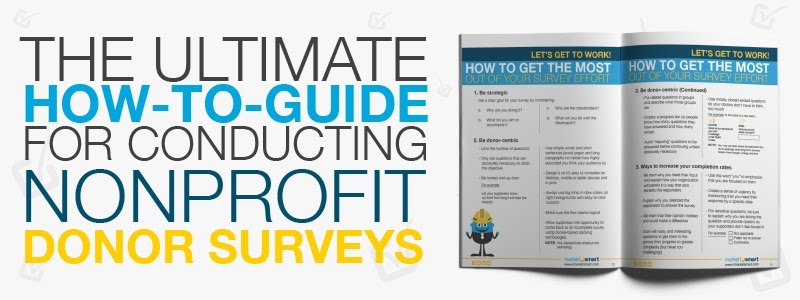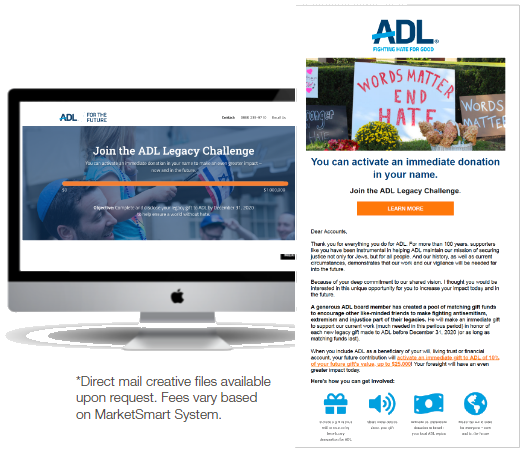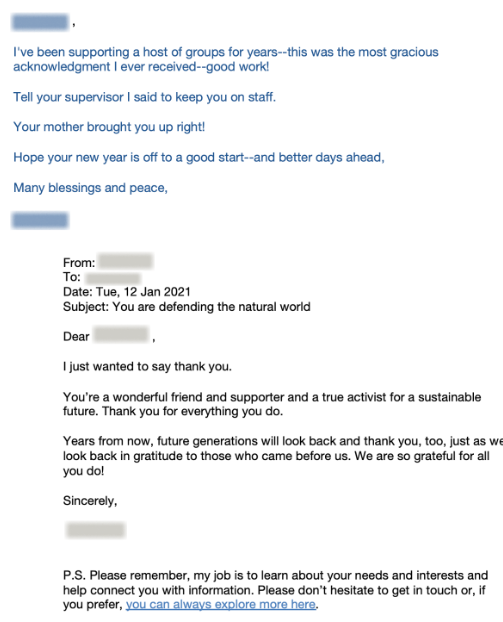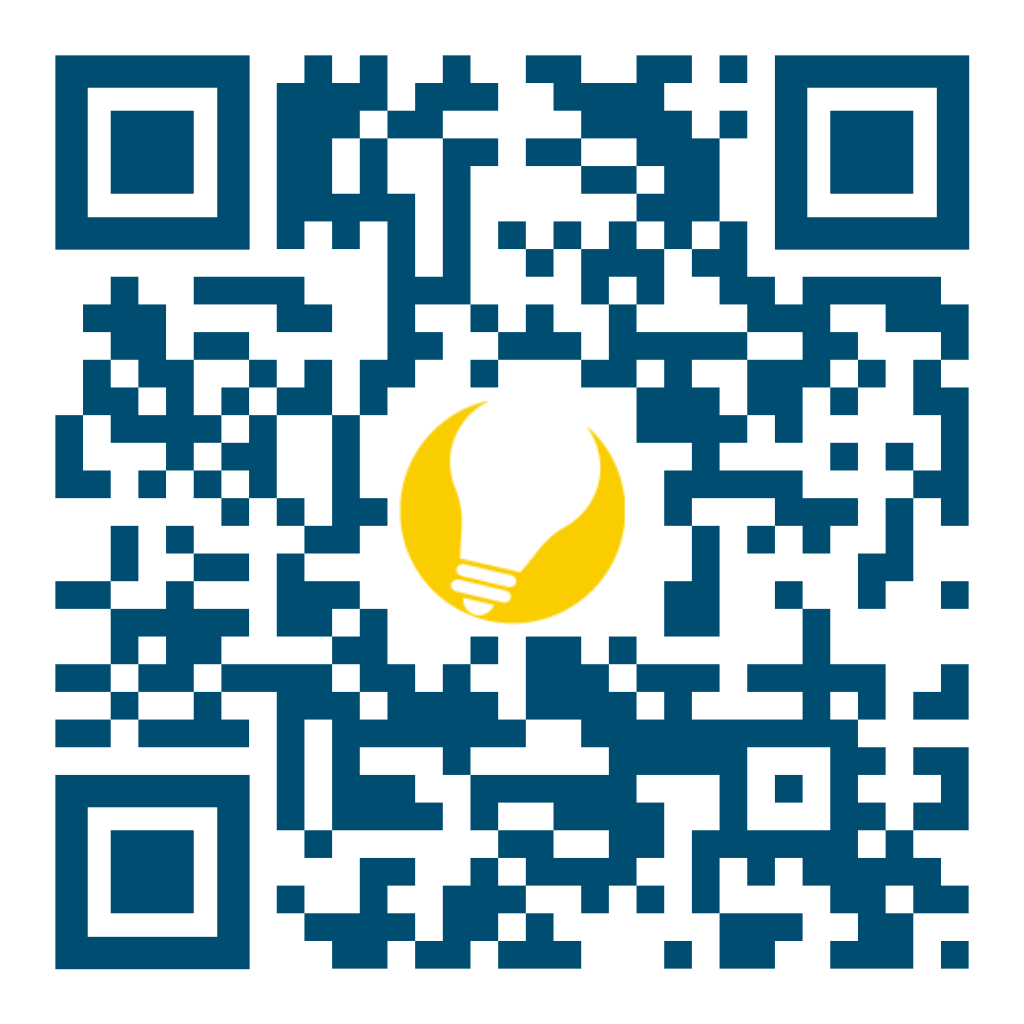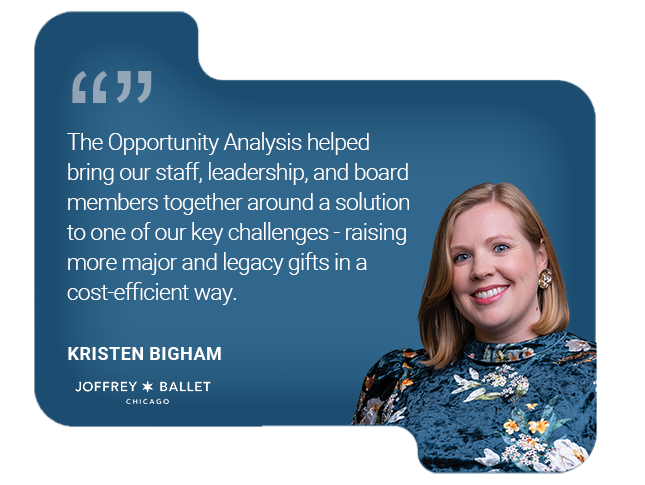Fundraising
Automation
The Nonprofit Leader’s Guide for Optimizing
Fundraising Operations with Technology
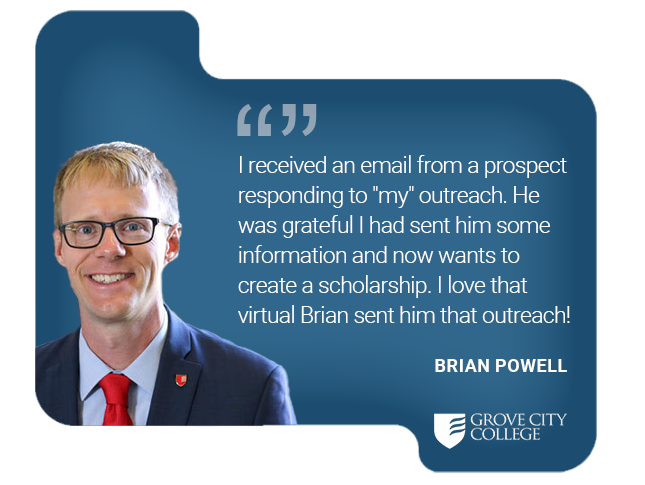
Fundraising is Getting Harder
You don’t just feel it. You know it from the data.
Retention is getting tougher. Attracting new donors is becoming more costly. The one bright spot of late has been that major gifts have increased, which has compensated for losses in other areas.
For now.
The question is, can this be sustained?
If you’re like most nonprofit leaders and fundraisers, you’re a bit worried that it can’t. To do fundraising well, it requires significant increases in staff, money, and time. In other words, all the things we never have enough of in nonprofit fundraising shops.
But now there’s this tool out there called marketing automation. You’ve probably heard of it. You may have even looked into it.
Marketing automation allows you to do more with less
When you hear about the broad benefits, it seems like the perfect solution to your problem of needing more of all the things you don’t have: time, money, and personnel.
Marketing automation leverages technology to speed up communication between your nonprofit and its current and potential donors while letting
fewer people slip through the cracks. It also frees up staff time by liberating them from mundane tasks. And it reduces costs.
Put all this together, and marketing automation seems like the ticket for increasing your fundraising efficiency without increasing costs or staff time.
It’s like Netflix compared to Blockbuster.
You do remember Blockbuster Video, right? If you’re under 30, go ask your parents about it. Blockbuster was the #1 video rental chain in the nation for many years.
They had over 9,000 stores, over $6 billion in revenue, and 85,000 employees at their peak in 2004.
Today, they have one store—in Bend, Oregon.
What happened?
Netflix happened.
By delivering a similar but more convenient, tech-enabled service at a far lower cost, Netflix obliterated Blockbuster. They did it because they were able to automate tasks that had to be done in person and in physical stores at Blockbuster.
As of 2021, Netflix generates over $20 billion in annual revenue, more than three times what Blockbuster made at their peak (not adjusting for inflation).
But here’s the most important comparison:
Netflix is generating more than three times the revenue with one-tenth the employees. They have 8,600 employees. Their revenue per employee is over $2.3 million, compared to about $70,000 for Blockbuster at its peak. That’s 32 times more revenue per employee! All this was made possible because Netflix leveraged technology to its advantage. And now, you can do that, too.

So what about nonprofits?
When you look at those numbers, maybe you wonder, as I did, why nonprofits can’t do something similar. Sure, we’re not renting movies or TV shows, but we are trying to communicate with a lot of people at one time using finite resources and personnel.
The problem is, when you look into marketing automation to optimize your fundraising operations, all you find are companies like Hubspot, Marketo and Pardot (part of Salesforce.com’s marketing bundle). They are great tools, but they require you to do all the work to populate them. That takes time and requires expertise. Both cost money.
Plus, they don’t really speak ‘nonprofit.’ That’s because their platforms are set up for for-profit businesses, not nonprofit ones.
They also don’t recognize the fact that you’re short on staff, your training budget is tiny or nonexistent, and your organization is likely to experience high rates of staff turnover, making training investments unprofitable.
In short, those programs know private sector business operations. They don’t know fundraising business operations like yours.
Private sector marketing automation platforms aren’t the right tool for the job.
What you’re going to learn in this report is how nonprofits can take advantage of technology (especially marketing automation) to achieve the types of scaled-up efficiency you hear about in the private sector.
You’re also going to find out why it’s more urgent than ever to start automating your fundraising communications now.
We’ll talk about the current state of nonprofit fundraising—which is more dire than you might realize.
Then, we’ll show you some of the tasks you can delegate to marketing automation technology—which we will frequently refer to as fundraising automation because of how uniquely it gets applied to your context. You’ll see why this must look different from regular business automation, especially with regard to major gifts fundraising, mid-level donor migration and legacy gift promotion.
And finally, we’ll walk you through everything fundraising automation can achieve for your nonprofit, and how this will allow your fundraising team—and your donors—to be happier, less stressed, more fulfilled, more valued and respected.
In other words, we’ll show you how fundraising automation can not only improve your operations—especially with regards to its fundraising effectiveness—but how it can also help your staff be the fundraisers they always wanted to be. As a result, it will help you increase employee satisfaction, so staff stay put and the best in the field desperately want to work for you.
The Urgency of Leveraging Fundraising Automation
As you look at the data we’re about to reveal, you’ll understand why we call this fundraising climate change. It’s there, and if you don’t do something to stave it off, your organization could be forced to downsize, merge, or perhaps even shut down.
The data of fundraising climate change
When you look at nonprofit revenues these days, as we have, you’ll learn some startling facts:
- If your organization is like most, 68.43% of your revenue is coming from just .77% of your donors—the high-dollar donors.
- And even more extreme, on average, only 6.33% of nonprofit revenue comes from most (76.12%) of the donors—the low-dollar donors.
Don’t read over those numbers too fast. Look at them again.
More than 3/4 of your revenue is coming from about 3/4 of 1% of your donors!
You are not alone. Most nonprofits devote the vast majority of their fundraising budgets to reaching low-dollar donors. They get addicted to acquisition, but drop the ball on retention. So, if you’re like so many others in the sector, you’re probably spending most of your money on reaching people who only supply 4.96% of your revenue and are unlikely to make a major gift—assuming they stick around at all.
Fundraising automation enables you to do more and do it better, without sacrificing so much of your budget or time. You’ll see how in a bit.
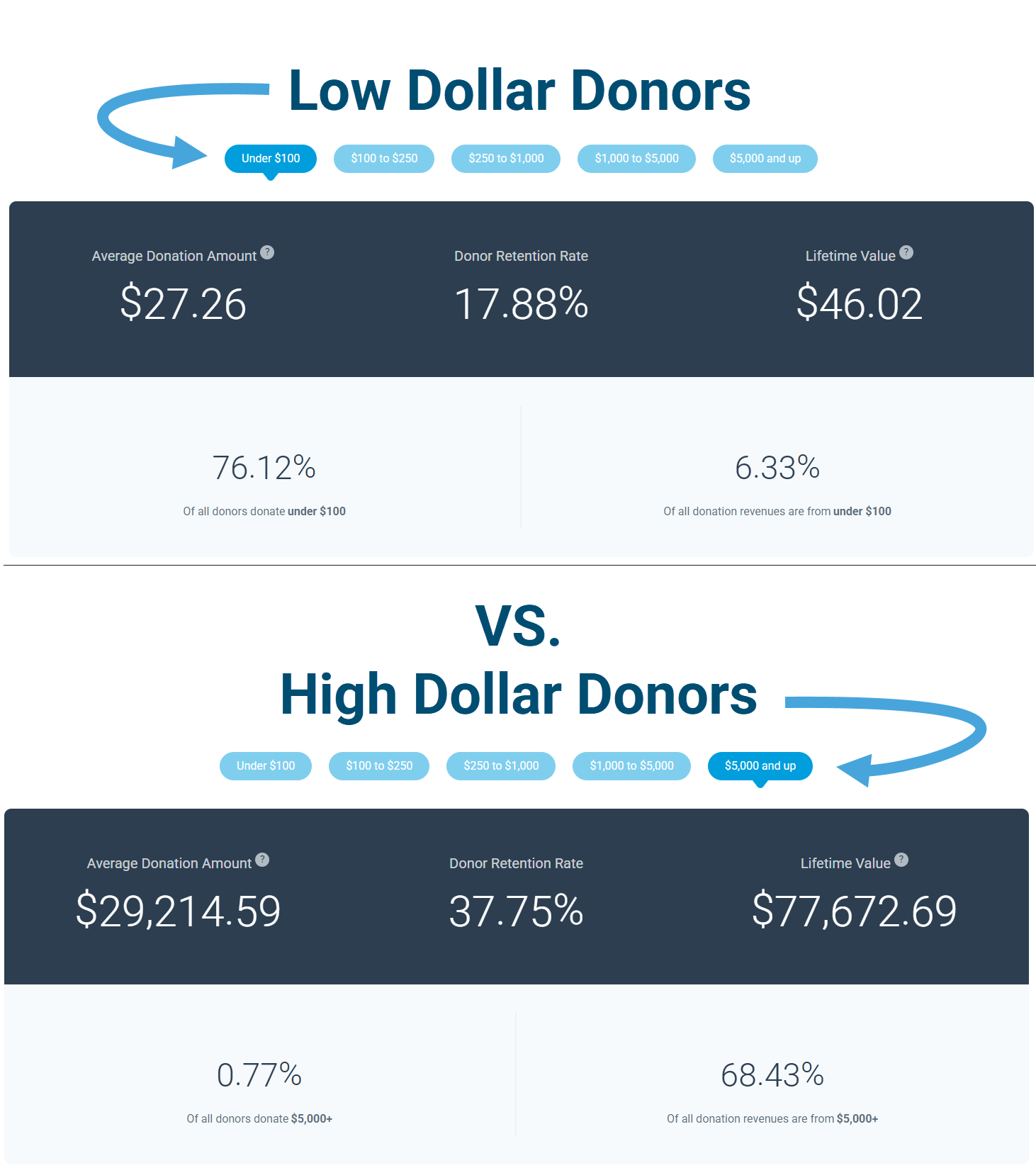
2024 metrics compiled from data submitted to the Fundraising Report Card by over 15,000 organizations and institutions. See how your metrics compare for free at www.fundraisingreportcard.com.

Traditionally, fundraising budgets have been lopsided, with investments focused too heavily on reaching low-dollar donors, even though 67.28% of your revenue is likely coming from just .59% of your donors.
The disappearance of low-dollar donors
Dollars up, donors down.
According to a study from the Lilly Family School of Fundraising at Indiana University, the share of Americans donating to charity has declined over the past 18 years from two-thirds to only half.

That sounds pretty bad. And it is. Clearly, donors are disappearing!
However, before we get to how fundraising automation can help your nonprofit reverse these trends, there’s another way to look at the data that shows why growth is more than possible, even in this environment of fundraising climate change:
The Fundraising Report Card found that first time donors who gave $5,000 or more were just about twice as likely to give again compared to first time low-dollar donors who gave less than $100.
What does that tell us? Major donors don’t just give more, they also give again at far greater rates. So, if you can win more major donors to your cause, you will also be much more likely to keep them.
To make it crystal clear how much this matters, let’s compare two sets of donors: those who give less than $100 and those who give over $5,000.
Add to this the increased costs of fundraising in general, whether that’s social media advertising, printing costs, postage costs (which increased by an average of 6.5% in 2020 alone), telemarketing or events, and you start to see the problem.

There’s simply no way to make a serious impact on your mission with lopsided fundraising budgets that are too heavily focused on raising money from the low-dollar donor category.
With lower giving amounts, lower retention rates, and lifetime values averaging just $45 per donor, populist fundraising will have to wait. Especially since the tiny group of high-value contributors gives an average of $75,468 over their lifetimes and they become repeat donors at almost twice the rate of low-dollar donors. Plus, sector wide, 82% of legacy gift dollars come from this smaller donor category.
The necessity for change
Are you doing things the way you’ve always done them? Data like this illustrates massive change in the fundraising climate. If you ignore it, you could be putting your organization’s long-term financial health in serious jeopardy.
Notwithstanding, you CAN thrive in the era of fundraising climate change. You CAN fish where the big fish swim. Read on to learn how.
What Fundraising Automation Can Do for You
What you’ll quickly realize as we get into this is, fundraising automation doesn’t do anything new. It just does what you already know you should be doing, but better.
Let’s consider the keys to effective marketing:
- Personalization
- Relevance
- Timeliness
- Repetition
- Efficiency

Personalization
Sending out mass email blasts has its place, but nothing gets greater ROI or deeper engagement than personalized emails. The same is true with direct mail, which is why nonprofits attempt to include things like past giving amounts in their fundraising letters.
Fundraising automation elevates your ability to personalize your donor outreach in ways that were impossible using the old approaches.
Relevance
Imagine sending out a letter about planned giving that offers helpful tips on communicating with family members about an estate plan, such as how to discuss money left to heirs.
That’s great, except how will people who get that letter feel if they have no kids?
The more you know the person you’re marketing to, the more relevant your communications will be.
Timeliness
Receiving a thank-you email or card two months after donating isn’t very friendly. Marketing automation enables you to decide when and how often you will communicate with the people on your list. It allows for quick and timely follow-up. Or it allows for automated cultivation that resonates with a donor’s consideration stage and interest in giving at a particular time.
Repetition
Good marketing, especially for highly considered decisions related to making major or legacy gifts, should involve repetition so you stay on their minds and they don’t forget about you.
Repetition is the only way to rise above the noise and remain part of your supporters’ lives—as long as your communications provide value to the recipients (and aren’t always overly solicitous). Fundraising automation makes repetition easy to administer.
Efficiency
What’s the most inefficient form of fundraising? Going door-to-door. It’s exhausting and expensive, even when it works. Telemarketing, direct mail and event fundraising have become increasingly inefficient too.
Efficient marketing looks for ways to persist in effectively engaging with supporters without wearing out the fundraiser or their budget… and fundraising automation protects both.
Donor cultivation and stewardship depends on performing as many of these tasks as possible. Fundraising automation is how you get them done properly and at low cost. Without automation, performing these tasks can be very time-consuming and tedious. It’s hard to keep up.
With automation, your people can devote their time and energy to more of the fundraising tasks that technology cannot do, like meeting with high-value supporters, preparing proposals, and negotiating and closing big gifts.
Basic fundraising tasks that nonprofits usually automate
We’ve hinted at a few of these, but let’s be clear on what we’re talking about. Here’s a partial list of some of the tasks that marketing automation can take off your plate. Most organizations automate these simple tasks using CRM (Customer Relationship Management) or email software.
Set-it-and-forget-it campaigns
If you create an email campaign, you can schedule it to send at a later time, automatically. Then you won’t have to think about it again. It’s done.
Autoresponders
When someone donates, joins your email list, signs up to volunteer, or performs any number of tasks on your website, you can have a pre-written email that automatically goes out in response. That email speaks directly to the action the person just took.
Thank-you emails
This is a specialized form of autoresponder that stands alone because of the great value it represents. A study by McConkey-Johnston International in the UK found that first-time donors who get a personal thank you within 48 hours are four times more likely to give a second gift.
With automated thank-you emails, you will never miss sending a prompt and timely thank-you again.
Giving receipts
Giving receipts are about more than just tax records. They speak to your credibility and trustworthiness. Did they actually get my donation? Are they aware that I exist? Or did my money just fall into a black hole?
If you’ve ever donated and heard nothing in response, you know how that feels. It’s not good. Automating your giving receipts is ‘square one’ when it comes to fundraising automation.

Is ‘basic’ the best use of automation technology?
Not really.
All of those basic automation tasks have great value. All of them fulfill the marketing tasks listed earlier. But all of them solve problems mostly related to managing low-dollar donor communications. That means you’re putting your automated systems to work mostly to communicate with the people who supply about 7% of your individual donor revenue.
To be clear—it’s still worth doing. You’ll save time and be more efficient. You’ll engage lots of donors better and more frequently. And you’ll make them feel appreciated.
All of that is good and worth pursuing for all of your donors. But consider again that the average major donor gives over $75,000 to a single nonprofit over their lifetime, compared to just $45 from the average low-dollar donor.
If you could use fundraising automation to solve some of your greatest time-sucking challenges related to raising major gifts—including legacy gifts—and helping mid-level donors move themselves up, wouldn’t you want to do it?
Let’s explore how you can do just that.
Going Beyond Basic Automation
Basic automation is a no-brainer.
It works well for routine tasks and it’s fairly easy to implement—especially because it doesn’t require very much strategic thinking. However, more sophisticated challenges (like raising major gifts and migrating mid-level donors) require more refined game plans.
Imagine this: What if you were to promote a supporter survey on your website or social media? And, what about offering a video, special report or eBook telling the story of one of your beneficiaries? What would happen after your supporters explore any of those offers?
Nothing?
Or would you have a strategic follow-up plan in place? And would that follow-up plan be effective? How would you know?
Imagine if you could send automated, personalized and relevant follow-up sequences and you could measure their effectiveness (with metrics like email opens and clicks as well as meetings set and gifts closed).
Armed with information your donors provide in surveys, questionnaires or forms your supporters would need to fill out in order to read downloadable materials, you’d be able to properly follow-up with new leads and potential donors. But you wouldn’t be able to do it at scale. Not without automation.
Fundraising automation allows you to create personalized and relevant follow-up cultivation sequences (not one-offs) based on why your supporters care, what they’d like to support, how they’d like to support it (with cash or assets) and, most importantly, where they are in the consideration process for giving. After all, timing really is everything.
Look, getting a fish to bite is great. But you have to pull it all the way in before it does you any good. That’s why your automated efforts need to be well thought out and sequential. Otherwise, they’ll just seem transactional, robotic and unsentimental.
Absent inspirational follow-up, you’ll be less likely to land the meetings you need to qualify donors and properly populate your caseloads—leading to more meaningful relationships and more consequential support.
Populating caseloads and generating major gifts
How do you attract new major donors or turn low- and mid-level donors into major donors? And how do you make sure your current major donors come back, plan a legacy gift, and refer their friends?
Let’s be frank. It ain’t easy.
Without automation, you have to identify and qualify potential mid-level and major donors from vast lists of prospects and donors, often supplied to you by wealth-screening companies or prospect researchers.
That’s hard. It takes time and costs money.
Then you have to develop a plan to reach out to those folks. This might include phone, email, in-person meetings, and all the rest. That’s hard, too. These days, it’s harder than ever to get someone to answer their phone or respond to your email outreach.
If you do reach them via a traditional approach (without automation) and they are interested, you still need to conduct donor discovery one-on-one. That’s especially challenging because it’s time-consuming and donors won’t always tell you what you need to know.
And why would they? You’ve got to earn their trust over time in order to get that kind of information. So you need to be patient. But your boss and board are breathing down your neck. Your cause needs money now.
However, fundraising automation can leverage technology to effortlessly enhance this entire process in profound ways, some of which we’ll discuss later in this report. And in case you’ve been wondering, yes! By leveraging technology for automation you CAN perform donor discovery and cultivation tasks more easily and at scale.
Plus, by removing these rather mundane, low-margin tasks from your highly compensated gift officers’ duties, you will help them stay focused on exponentially more sophisticated aspects of their jobs. The result will be more effective, more engaged and happier fundraising staff.
Can you afford to invest in automation?
First, consider why major gifts fundraisers fire their employers. The best major gift fundraisers quit because they love to interact with people.
Stay with me on this.
Believe it or not, it’s hard to give money away. That’s why the Bill and Melinda Gates Foundation employs more than 1,600 people.
Major gifts fundraisers like to help people navigate the philanthropic giving decision-making process. They enjoy helping donors think carefully about their choices. They see themselves as facilitators, not solicitors.
And they absolutely love helping donors make an impact, especially if it’s through your organization. They cry tears of joy alongside benefactors as they partner to make a positive impact in the world.
That’s the bread and butter of major gifts officers’ work.
Here’s what they DON’T enjoy so much:
- Sitting in meetings;
- Helping arrange events;
- Feeling overworked, underappreciated, and undervalued;
- Having more prospects on their caseload than they can possibly reach out to in a timely manner;
- Making cold calls and getting no response instead of warm calls that lead to meaningful meetings;
- Going on wild-goose chases thanks to false positives (pursuing apathetic prospects who aren’t truly qualified even though their wealth screening results say they are);
- Being pressed to solicit gifts from supporters who aren’t ready because they haven’t been cultivated properly (and there’s no time for cultivation because the major gifts officer is busy sitting in meetings or arranging events);
- Spending time developing marketing content without knowing what really works best to attract engagement from major donors;
- And so much more.
If you asked a random group of 100 major gift fundraisers how they spend their time, what do you think they would say?
A study conducted by Ruffalo Noel Levitz in 2017 essentially did just that. The respondents were seasoned fundraisers and leaders, having spent 13 years in advancement, with nine of those in major and/or planned giving (on average).
In general, the study found that fundraisers experience “significant pressure for their limited donor contact time, as well as frustration in finding good ways to focus on the right donors and amplify productivity.”
Here are some details:
- Fewer than ⅓ of the respondents believe wealth and prosperity ratings are highly effective.
- 86% used wealth ratings, but only 27% reported that wealth ratings were “quite effective or very effective for focusing on the right prospects.”
- Only 19% said that wealth ratings were “quite effective or very effective in helping to determine ask amounts.”
- Just 30% said that propensity ratings were “quite effective or very effective in predicting the likelihood for a prospective donor to make a major or planned gift.”
- The average size of their caseloads was 142, yet only 52% of their assigned prospects—71 supporters—received personal visits each year.
- Only 37% said the newly assigned prospects placed in their caseloads were truly qualified to be a major or planned gift donor.
- 92% said they stay engaged with donors and prospects by sending personal emails manually yet over half (55%) said they didn’t spend enough time on solicitation and 42% said they didn’t spend enough time on qualification.
- 50% said that they primarily have to qualify donors with face-to-face visits, while at the same time, 52% said they don’t have enough time to get it all done.
- Overall, they reported experiencing “significant frustration with the time spent setting up and completing qualification visits that did not ultimately lead to gifts.”
This is the cause of high turnover.
It’s a high-stress position with high stakes. But sadly, the support systems that are meant to make their jobs doable don’t deliver the goods.
Too often nonprofit leaders, board members and consultants place too much emphasis on solicitation. They overlook qualification, cultivation and stewardship. Some even say that the number one reason why people give is because they were asked. Then they drive fundraisers to ask, ask, ask.
That approach will generate some gifts. But it will annoy and turn-off plenty of people who simply aren’t ready.
Instead, fundraisers should be trained to ask when the timing is right. Otherwise, frustration and burnout will continue to run rampant in fundraising shops around the globe. The true reason why people make major gifts is complex and multi-layered.
How does high turnover among major gifts officers affect your nonprofit?
In short: you lose.
You lose time and money hiring and training new ones.
You lose details about high-value supporters that gift officers know and remember.
You lose opportunities with donors who had forged relationships with the fundraiser who just quit.
You lose donors who were ready to give, but by the time the new gift officer gets in touch with them, their situation has changed and they’re no longer interested, or they already supported a competitor with a similar mission.
You also lose quality. If you have a team of major gifts officers and your best one leaves, that means you have to rely on the ones who aren’t quite as good—the ones you were hoping to let go once you found someone better. Now you have to replace the all-star who left, and the subpar ones suddenly become temporarily indispensable.
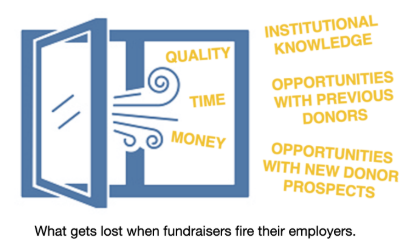
Do you really need more gift officers to raise more money?
Too many nonprofits mistakenly assume that the best way to increase major gifts fundraising is to hire more major gifts officers. To a point, yes. But this is not efficient. And because of turnover, it’s hard to sustain.
Plus, remember what happened to Blockbuster. They thought the best way to increase revenue was to open more stores. Then technology (Netflix) showed them a better way.
Sadly, too many nonprofits leaders don’t understand what’s involved with major gifts fundraising or how to get the best out of their people—even the all-stars. Too often, they hire more staff before an existing team is optimized.
For example, suppose you have a team of five major gifts officers. What is likely is that you have one all-star, a couple of average ones, and a couple of below-average ones.
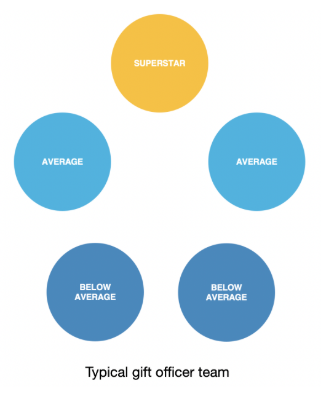
The challenge is to identify which is which, keeping in mind that major gifts often require six months to two years for donations to close (according to the 2020 Major Gifts Fundraising Benchmark Study).
In that time, how many great prospects have your poor performers driven away, ignored or lost?
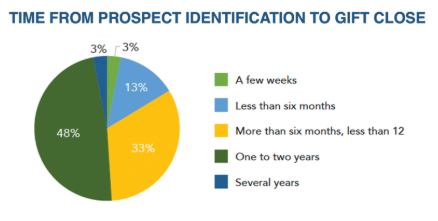
Finding and hiring top talent for a position like a major gifts officer isn’t simple, easy, or cheap. Depending on the specifics, here’s a list of hard and soft costs you incur every time you look to hire a new major gifts fundraiser:
- Recruitment costs: advertising, recruitment firm commissions, interviewing time
- Training costs: time spent on-ramping and getting them up to speed
- Management costs: your management time is money, too
- HR costs: performance plans, onboarding, offboarding
- Legal costs: especially because fired workers sometimes sue their former employers
- Equipment and facility costs: computers, office, cybersecurity
- Travel costs: air, train, car, hotel, dining and per diem
- Benefits costs: health insurance, vacations
Again, these are ancillary costs that come with having to hire for any position of great importance and with high stakes. But it’s still money you wouldn’t have to spend if the original person didn’t quit. The most serious costs show up as lost donors and lost opportunities, as already mentioned.So, in major gifts fundraising, turnover is bad. Destructive, really. And yet so depressingly frequent.
A better way?
What if there was a way to multiply your revenue while retaining your best staff, attracting the best fundraisers, and lowering or maintaining your major gifts fundraising costs? Fundraising automation can do this.
It can help one fundraiser perform like nine while supporting their desire to stay focused on what they do best—meeting with philanthropic-minded supporters when those donors are ready for a relationship.
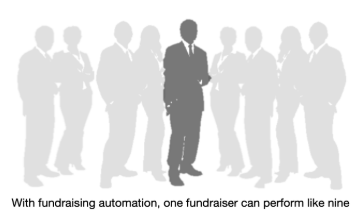
Optimizing Operations Through Automation
Building a more effective team.
If you could eliminate the low performers while keeping your all-stars delighted to work for your nonprofit, that would improve staff morale while solving all kinds of revenue problems, wouldn’t it?
Plus, imagine how much money you’d raise if you could attract the best fundraisers to join your team!
Earlier, we listed things your fundraisers dislike but spend so much of their time doing. Things like wading through hard-to-use lists of oversized caseloads filled with false positives, or qualified prospects who simply aren’t ready for outreach.
There are four tasks you can automate to relieve your gift officers of the burdens related to these challenges:
- Lead generation
- Qualification
- Cultivation
- Prioritization
If you automate these four essential tasks, you will attract and retain more of the best fundraisers (and donors). Your team will feel supported and valued, and not like they’re wasting all their time staring at screens, calling unqualified leads, messing around with lists, chasing false positives on wild goose chases or bothering qualified donor prospects when the timing simply isn’t right.
Your staff will be able to focus more energy and time on what they do best: meeting with philanthropic-minded people to help facilitate their giving when it’s convenient for them.
Plus, automating these four tasks enables you to better identify your poor-performing gift officers and remove them. After all, poor performers don’t generate enough revenue to justify their position. They are the weak links that bring down your team and increase your other costs because they require additional oversight from management and HR.
So, removing them will save you money while allowing your average gift officers to become above average—especially if they are fed highly qualified prospects who are ready for meaningful engagement. Fundraising automation can support that.
More revenue per employee.
Remember, Netflix leveraged technology to generate 32 times more revenue per employee than Blockbuster. You can do that too! As the diagram below shows, you can generate more revenue with fewer people.

If you make this work, your expenses will be about the same. You will still have five people, but now all of them will perform better. They will generate more revenue while costing you less time, money, and frustration.
With fundraising automation, all your major gifts officers will be able to perform at above-average level. Plus, they’ll stay put. They won’t seek other opportunities because, at your organization, they have a chance to become the fundraisers they’ve always wanted to be.
Three types of marketing automation
As you might recall, the lower-level, basic automation works better for low-dollar donors. Higher levels of automation support the more deliberate (and less impulsive) kind of decision-making process used by major and legacy gift donors.
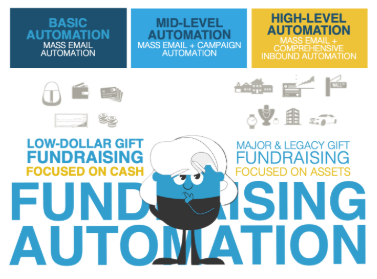
Three types of marketing automation
As you might recall, the lower-level, basic automation works better for low-dollar donors. Higher levels of automation support the more deliberate (and less impulsive) kind of decision-making process used by major and legacy gift donors.
1- Basic automation:
Mass email automation
Most of the email automation examples listed earlier fall into this basic category. This includes giving receipts, thank-you emails, autoresponders, etc. Most email delivery systems make it possible to create these types of automation and use basic personalization features like names, cities, and companies.
2- Mid-level automation:
Mass email + campaign automation
With these systems, you can increase personalization and create email scheduling as well as what are called drip campaigns: a series of messages at predetermined intervals.
Some mid-level automation systems include adaptive capabilities. For instance, you might have a drip campaign about funding a particular program, but you only want it to go to people who have clicked on a particular link from another email. With automation, once a person clicks that email, the drip campaign fires up and starts getting sent out.
Mid-level automations also often allow for lead scoring, which assigns point values to recipients based on actions they take. The more emails a person opens, clicks or replies to, the higher their score. Then you can identify your most active subscribers and look for special ways to reach out and engage them further.
3- High-level automation:
Mass email + comprehensive inbound marketing automation
Now, in addition to all the basic and mid-level features, you can create marketing ‘assets’ such as landing pages with forms (so supporters can subscribe or download information while you collect their contact information) and microsites (so they can involve themselves more deeply with news regarding how you make impact on their behalf or how they can give). You can also segment your lists in hyper-specific ways so you can make your automated emails more personalized and relevant. And you can track each individual supporter as they engage and navigate all of the above over time.
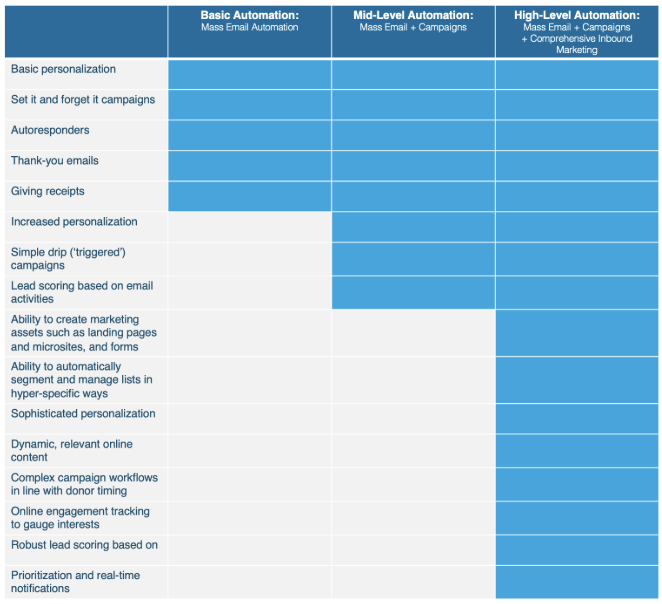
If you make this work, your expenses will be about the same. You will still have five people, but now all of them will perform better. They will generate more revenue while costing you less time, money, and frustration.
With fundraising automation, all your major gifts officers will be able to perform at above-average level. Plus, they’ll stay put. They won’t seek other opportunities because, at your organization, they have a chance to become the fundraisers they’ve always wanted to be.
Three types of marketing automation
As you might recall, the lower-level, basic automation works better for low-dollar donors. Higher levels of automation support the more deliberate (and less impulsive) kind of decision-making process used by major and legacy gift donors.
The major gifts angle
Major gifts (including legacy gifts) fundraising depends more on personalization, relevance, relationship, and timeliness than any other type of fundraising. It also usually involves communicating with one person (or a small handful of people) at a time. The only way to scale that level of communication in an effective way is with high-level automation.
Fundraising automation enables this level of engagement with high-value, philanthropic-minded individuals. Standard marketing automation doesn’t.
However, none of the usual big business automation platforms were built for major gifts fundraising. As a result, trying to reshape them into a version that serves your needs is like turning a baseball stadium into a soccer stadium. Yes, it can be done, in some cases. But it sure looks funny, and some people end up in really bad seats with terrible views.
That won’t sit well with most of your major gift donors, and it won’t work out well for your nonprofits.
How high-level fundraising automation facilitates major giving
Start by letting your best people do what they do best.
To recap, the four major tasks performed by major gifts fundraisers that can be automated are:
- Generating leads
- Qualifying donor prospects
- Cultivating and stewarding relationships
Prioritizing outreach so they spend time wisely and land more meetings that result in meaningful conversations centered around philanthropy
Remember, the best gift officers would rather be meeting with supporters. Offering them opportunities for involvement. Building relationships. Providing service. Facilitating decision-making. And, yes—asking for, negotiating and closing gifts.
They aren’t as interested in wild-goose chases—spending precious time noodling wealth-screening data only to find (⅔ of the time) that an identified prospect is not really qualified after all.
And they certainly aren’t interested in writing and testing which subject lines inspire supporters to open and click-through their emails. Or developing content offers, landing pages or microsites to engage supporters.
Support your team so they can support your supporters.
Let’s look at several of the biggest ways high-level fundraising automation can support your major gifts fundraising team. This is what any automation system must be able to do if it’s going to be worth your time.
What kind of communication is important for high-level donors?
1. Communicate frequently and effectively
Hearing from you often enough convinces people that you know what you’re doing. For nonprofits, this boosts confidence from the donor. Especially if your messages are non-solicitous.
You know it’s true. Your supporters want to hear from you. They want to be kept in the loop. It makes them feel valued and important. And it’s fair. Your mission matters to them. They deserve to know what’s going on.
But not only through solicitations. That’s annoying—sort of like a so-called ‘friend’ who only calls to ask you for a favor.
Instead, your supporters seek value. And if they get it, they’ll be more likely to respond favorably when they finally get asked to help.
Communicating frequently and effectively is all about providing value to your supporters in line with their interests and needs.
If your automation system can’t satisfy both those requirements, you should keep searching for alternatives.
2. Be relevant: tell them what they said they want to hear
Fundraising automation should be responsive to requests, preferences and stated desires.
Take the example from earlier. If you send out an email talking about a certain program and tell your readers to click on the link if they want to hear more about it, that means everyone who clicks that link is probably interested in that program.
With automation, you can speak to the stated interests, preferences and passions that are relevant to their lives.
Being relevant includes the timing of communication, too. How often do they want to hear from you, and when?
If I tell you I am only somewhat likely to consider a gift of appreciated assets, your nonprofit should listen and recognize that I’m not ready to make a decision to give. How would such a person feel if, after telling you that vital information, you went ahead and asked for a gift of stock right away?
Would they feel heard? Respected?
Or perhaps you sent them a survey asking for input about several branches of your overall mission. A wealthy potential donor responds. But your basic level automation offers no way of seamlessly segmenting your follow-up communications based on their survey selections. So your messages seem irrelevant.
Is this effective? Of course not. It’s annoying, and you wouldn’t like it either.
Fundraising automation helps you provide value to your high-value supporters by hyper-segmenting your communications based on their stated preferences.
3. Be respectful: consider your supporters’ consideration process
Giving a large gift isn’t just a transaction. It’s much more like a partnership. Your automation should be respectful of that, which is another reason why timing—and waiting—is so important.
When MarketSmart founder Greg Warner was in college, he had an experience that revealed the importance of respecting large gifts.
He was working for his school newspaper, trying to make ad sales to local businesses. He got a meeting with a local pizza shop owner. Had a great meeting. Showed him the ad he had in mind. The owner liked it. Said he was interested. So, Greg handed him a pen and asked, “Should we go forward with this?”
And here’s when it all fell apart.
The owner became quiet. He stared at the ad for a while. In the silence, Greg panicked and started blurting out facts, figures, and reasons why doing this ad was such a great idea. He went on with stories and anecdotes, assurances, and all kinds of babble. He even interrupted the owner a couple of times when he tried to say something.
Finally, the owner spoke up, and said, “Don’t they teach you anything about how to close a deal in college? I was thinking! Now get out of my shop!”
Greg failed to give him consideration time. He jumped the gun. Overplayed his hand. Call it what you want.
The point is, anytime someone is spending or donating what represents a large amount of money to them, they want time to think about it. This is not a snap decision.
Out of respect, your fundraising automation needs to accommodate the time it takes to consider a major gift.
4. Be polite: reserve calls and meetings for when they matter most
Some fundraisers and organizational leaders put too much emphasis on vanity metrics (open rates, click rates, etc.). They press their staff to make calls and visit people no matter how qualified or ready they may or may not be. But not everyone needs a philanthropy facilitator—especially if they aren’t ready.
Plenty of donors just don’t want to meet. Some want to give anonymously. Some want to call you up and initiate their gift. And, yes indeed, some are happy to participate in calls and meetings.
The point of all this is that fundraising automation can sift out the donors who want meetings and phone calls from those who don’t, so you don’t waste your time trying to talk to people who don’t want to hear from you.
If your automation system can’t help you do this, keep looking.
5. Reduce pressure on the donor and the fundraiser
This is a big one. You likely face constant pressure to deliver revenue and results. Your donor prospects can sense it. They aren’t stupid.
What if you could look at a list of 100 prospects in your fundraising automation system, and know that 93 of them aren’t ready to be called or met with this week, or even this month?
That means you would only have seven to reach out to for the month. Whew! Can you feel the tension and pressure pouring out of the room?
As a result, you could spend more time on strategy, ensuring that your outreach will be successful. This is just one way fundraising automation can reduce pressure by giving you breathing room to do your job the right way.
6. Be analytical: identify who is actually engaged
How does fundraising automation empower you to know that 93 out of 100 major gifts prospects don’t want to hear from you this week or month?
Using tools like lead scoring (mentioned earlier), your automation can monitor your metrics. It can show you who is opening and clicking on emails, when they are engaging with them, how much time they’re spending online with your content, how you rank in the list of organizations they support, whether they’re interested in speaking with a gift officer or not, and many other indicators of engagement.
If a prospect is digitally inclined but hasn’t opened an email in several months, they probably aren’t the best person to call up. They’re not thinking about you right now.
Engaged donors give and give more. Disengaged donors don’t, and bothering them when the timing isn’t right only drives them further away.
Without automation, being analytical takes time. With automation, it doesn’t.
7. Be efficient: uncover who is truly interested in making larger gifts
Fundraising automation helps supporters lean in and self-qualify so you can filter and segment large lists of donors, subscribers, event attendees, and anyone else in your list. Over time, as you use the system to its full potential, the cream will rise to the top.
Consequently, your major gifts officers will be able to easily determine which contacts are likely to be dead ends and a total waste of their time and energy. This is essential because when fundraisers waste time pursuing people who were never going to make a large gift, what happens? The good candidates get neglected.
Fundraising automation eliminates this problem so you and your staff stop wasting valuable time on unqualified false positives sourced solely by other means.
8. Be donor-centric: learn how a prospect prefers to give
Some people prefer to give appreciated stock. Some like to write checks. Some like being challenge sponsors or lead donors of a campaign. Some like to fund big projects with opportunities to gain notoriety. Some like to fund back-end costs so your fundraising campaigns can claim that 100% of everyone else’s donations go directly to the cause. Some want to give using their IRA, family foundation, or donor-advised fund (DAF).
In fact, DAFs have multiplied in popularity the past few years because of the convenience and flexibility in deciding when and to whom to give. But it doesn’t make much sense to send out emails about DAFs to a bunch of people who have never heard of them. In fact, the best way to generate DAF gifts is to first determine who has one.
Fundraising automation can be used to monitor who is clicking on your DAF widget online, or work in conjunction with a survey to discover giving preferences. Then it can segment your large donor-prospect lists accordingly so you know how to follow up with them best.
9. Be gracious: bolster your follow-up after the gift
What happens after someone makes a large donation?
Even the most passionate and well-intentioned donor will immediately start wondering what you’re doing with their hard-earned money. It’s just human nature.
They will now be thinking more than they ever did before about your organization’s professionalism and credibility. They’ll start asking themselves if maybe that one gift is enough.
“Should I remain involved, or should I move on to something else now?”
If you give the cold shoulder and the silent treatment to a donor after they make a major gift, or if you fail to show them the value of what their money has accomplished, you greatly increase the possibility of creating ‘donor remorse.’
Just like buyer’s remorse, donor’s remorse is the death knell to donor retention.
Fundraising automation ensures that donors who have made large gifts or planned legacy gifts continue to be served, thanked, valued, appreciated, respected, informed, and engaged.
10. Be effective: assign prospects to persona buckets
Automation can create segments seamlessly. It can group people by age, how passionate they are about your mission, where they reside in the consideration process for particular gift vehicles, whether or not they have kids, and many other factors.
Persona buckets are one form of segmentation, but they represent much more than mere demographics and factual information.
With personas, you’re grouping people by shared commonalities.
Consider this. Thanks to a survey, you’ve collected valuable self-reported donor discovery information (‘verbatims’). Then, thanks to fundraising automation you’ve monitored each supporter’s engagement online. Together the data helps to carve out a group of older (over 70) supporters with no children who said they’d be likely to leave the remainder of their IRA savings to support your cause as a bequest and who’ve clicked on information about such a gift online.
If you put all those supporters into one bucket, you can now ‘speak’ to them on a much more personal level. You can speak to their interests as they relate to the stage of the consideration process in which they reside, and they will value your messages much more because they will be relevant and fitting.
Do you know how powerful that is?
Every nonprofit’s list can be broken up into persona buckets that will allow you to more authentically connect with supporters effectively—thereby providing a higher level of donor delight. But you can only achieve this with high-level fundraising automation. It would be nearly impossible to do this, and maintain it, any other way.
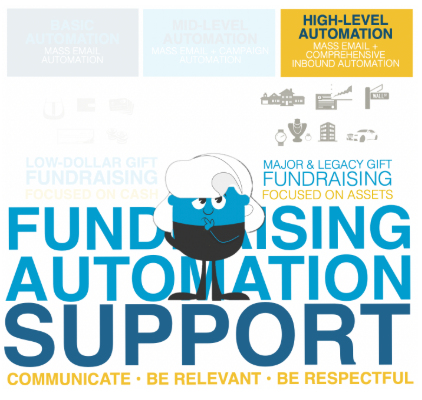
Putting Automation To Work With Verbatims and digital body language
Okay, so you’re starting to see what fundraising automation can achieve for your nonprofit. But how can you put it together so your staff can be the fundraisers they want to be?
While automation can do many things, next we’ll focus on just a few specific types of content you should use to get the most out of any fundraising automation system. If you employ them properly, you’ll collect two types of data that are essential for success:
- ‘Verbatims’: the things supporters tell you. You can collect ‘verbatims’ from one-to-one email responses that come directly from your supporters after they receive your offers for engagement. These ‘replies’ are serious qualifiers that fundraisers can use to generate more dialogue, build trust, and grow relationships.
- ‘Digital body language’: what supporters do online. These are captured thanks to technological tracking. This data helps you understand what each supporter (by name and donor ID#) is doing online as they navigate your web pages in real time so you can act immediately. This data might include the amount of time each supporter spends viewing your content, where they click, what videos they watch, what they share, and what they download. It is important to capture digital body language because what people say doesn’t always align with what they do.
Next, you’ll learn how you can capture both of these very important types of data.
Don’t just ask... offer!
As we mentioned previously, people (especially high-value donors) are tired of hearing from their favorite causes mostly through solicitations. Instead, they want invitations for engagement so they feel involved and educated.
Sure, an opportunity to donate is an invitation for engagement. But it’s one that should be reserved for when a supporter has signaled their readiness to receive it. Most of the time, you should offer them cultivation or stewardship communications that include value-oriented, highly relevant, personalized content offers.
Include links to your offers in your automated emails so your supporters fill out forms (mini-questionnaires) on landing pages. By providing offers that resonate with your supporters, you’ll encourage them to lean in so you can capture ‘verbatims’ and ‘digital body language’.
Offer something supporters value and you’ll raise more money
At first, providing valuable offers to major donor prospects might feel a bit counterintuitive. After all, the core function of your job is to ask, not give. However, at MarketSmart, we have found that generous fundraisers inspire generosity among their caseloads of supporters.
However, it is important to remember that value is in the eye of the beholder. So you must use the ‘verbatims’ your supporters have supplied, along with the ‘digital body language’ you collected, to ensure that you deliver offers that resonate.
Once that standard is met, you will also want to consider this MarketSmart checklist. It will help you decide whether your offer idea is really worth developing and offering to your supporters.
- Is your offer fun?
- Is it fair?
- Are you being honest and transparent?
- Will it educate or inform?
- Is it shareable?
- Does it evoke emotion?
- Does it release dopamine and/or oxytocin (make them feel good)?
- Does it help them feel like they are the hero in their own life story (provide feelings of autobiographical heroism)?
- Does it give them a sense that they can live forever in the minds of others (provide feelings of symbolic immortality)?
- Does it enable them to give back or pay it forward to others?
- Does it allow them to feel that they are being altruistic?
- Does it provide a sense of community (a connection with others)?
- Does it give them notoriety and/or praise?
- Does it enable them to right some wrongs they want to change in our society?
- Does it give them a feeling that they may be able to satisfy their religious or moral principles?
Bottom line: If an offer idea does not provide value to your supporters, don’t use it!
Here are some content offers we have found are most effective for helping supporters engage and move themselves through the major gift consideration continuum.
Supporter surveys
There’s pent-up demand among your base of supporters (including donors, volunteers, social media followers, and advocates) for a chance to enter into an arms-length conversation with you—especially at the early stages of their consideration process for making a major gift.
That’s why a supporter survey is the single most effective offer you can provide. Remember, if you ask people for advice, you get money. If you ask them for money, you get advice. Especially when the relationship is new.
But surveys are only valuable when you use the data you capture to show your donors you have listened to their responses… and the best way to do that is with fundraising automation.
Ever since MarketSmart pioneered combining surveys with marketing automation emails, a number of firms have sought to sell a similar concept. Unfortunately, they usually only sell surveys. They fail to tie each supporter’s survey responses to a marketing automation system that can spawn automated emails based on the ‘verbatims’ each individual supplies.
That’s too bad because cultivation is the key to effective fundraising. A survey is just a tool to gather information that should be used for cultivation. If the two are not tied to one another, donation revenues often actually decrease among those who took the survey.
When you stop to think about it, that makes perfect sense. Once a wealthy, older, philanthropic-minded person gives you their most precious asset—their time—shouldn’t they expect your communications going forward to show that you listened?
Marketing automation helps prove you did.
Sudden solicitations will make them feel unappreciated and possibly even misled. After all, by taking your survey, they showed you they wanted to be heard. And by offering it to them, you implied you would listen.
So be careful with surveys. They are, in fact, just tools. Like hammers, they can be used to either build or break things. If you only use them to ‘take’ information from your supporters, you’ll fracture (or possibly shatter) their trust.
Alternatively, if you use surveys to ‘show them that you know them,’ you’ll engender engagement and goodwill. You’ll collect valuable information. And you’ll grow their trust as you cultivate the relationship—automatically!
Through a survey, you can ask about interests and passions, why they care about your mission, where they reside in the consideration process for making a gift, whether they’d like to make that gift with cash, assets, or after their lifetime, and so much more.
Then, with a well-designed fundraising automation system, you can continually provide value. Your communications will resonate as you check each supporter’s pulse (so to speak) by monitoring their ‘verbatims’ and ‘digital body language’.
It’s a polite-yet-persistent tech-enabled donor discovery and cultivation methodology, delivered at scale—thanks to fundraising automation technology.
Other content offers
Most prospective major donors spend the majority of their time in the WHY stage, wondering, “Why should I care, get involved, or give?”
If your cultivation is done well, they will move themselves into the HOW stage and wonder, “How should I give?” But that will take time. A lot of time. Going through the stages of considering a major gift is a marathon, not a sprint.
However, there is a way to help your supporters move themselves forward through the consideration continuum. Novelty!
Novelty makes people feel good. It provides variety that is attractive because people are naturally drawn to opportunities to acquire new information or become involved in fresh, new experiences.
Researchers at University College in London studied this in 2006. They found that novel information and experiences trigger the release of dopamine—the feel-good hormone our bodies produce —making us feel there’s a reward waiting around the corner. Their research suggests that we associate positivity with novel offers.
Researchers also found that novelty improves memory. By combining new information with familiar information during learning sessions, their subjects’ memories of the familiar increased by 19%.
So providing your supporters with new information, or new ways of engaging with familiar concepts, helps them understand and retain your organization’s mission, need, and how they can make an impact.
Also, that new information should be designed to appeal to supporters based on where they reside in their consideration continuum.
Here are eight novel offers our experts at MarketSmart recommend our customers employ: storytelling, digital newsletters, door openers, IRA QCD efforts, online will tools, legacy challenges, DAF efforts, and stewardship series. Let’s look at each.
To learn more about how MarketSmart helps hundreds of organizations raise money using these offers, sign up for a purely educational, no-pressure demonstration here.
1. Tell Your Story
Our Tell Your Story marketing tool works because it offers supporters an opportunity to think about their lives and how their story intersects with your cause. When a supporter shares a story about their unique experience, they deepen their relationship, connection and commitment to your organization or institution.
It gives supporters an opportunity to share their stories and read stories from others about their connections to your mission. It does this by driving traffic from email and social media (and possibly print) to a dual-purpose landing page that both asks visitors to share their stories and provides a place to display submitted stories from others in an engaging way.
It also evokes nostalgia, a powerful motivator in charitable giving. Nostalgia is a very personal, social emotion that involves momentous life events and social bonds—and charitable giving is a very personal, social behavior.
Inspiring nostalgia among supporters increases charitable intentions because it puts supporters in an ideal frame of mind to consider their philanthropy. At the same time, this fundraising automation effort helps gift officers collect valuable information from which to start a more meaningful initial conversation.

2. Digital Newsletter
People inherently want to feel a sense of belonging. They want to feel like they are part of a community.
Research has found that a sense of belonging helps give meaning to our lives, which can positively affect our well-being in many ways.
A properly developed digital newsletter can foster this sense of belonging and community. And, when done right, it can steward current supporters so they feel they are part of a tribe of like-minded individuals.
Plus, a digital newsletter can save you money! Since printing, mailing and postage costs keep increasing, now is the time to help more of your supporters migrate online—especially since your oldest supporters are online too (thanks to the pandemic and Zoom!).
Here are some additional benefits you could gain from a Digital Newsletter Effort:
- Create an insider experience.
- Generate awareness about giving opportunities.
- Steward supporters by engaging them with mission impact and supporter stories.
- Inspire existing donors to give again and possibly increase their giving.
- Offer free resources to help supporters volunteer or donate assets.
- Uncover supporters’ interests by monitoring their digital body language.
3. Door Opener
According to Jerold Panas, author of Mega Gifts, “It is a plain fact of fundraising that it’s often far more difficult to get an appointment than to get the gift.”
Not anymore!
The Door Opener quite literally opens doors to conversations for you. It is a high-level automated workflow that includes an email invitation for supporters to arrange meetings with your staff. It employs a tested email/meeting invitation, a mini-questionnaire that gathers information regarding what each supporter wants to discuss, and a seamless integration with an app that helps schedule appointments without the usual back-and-forth emails. When done well, your supporters will appreciate that you made such an offer in such a conscientious way.
This powerful, novel tool:
- Makes it easy for your top supporters, who are in the “how” stage of their giving consideration, to schedule an appointment with a fundraiser.
- Allows them the opportunity to guide the conversation and provide more information about their goals for the meeting.
- Gives them the chance to choose how they want the organization to engage with them in the future.
Your organization will get more than just meetings from your Door Opener because it:
- Helps to land meetings with highly qualified donors and prospects who are ready to meet.
- Eliminates the time spent on time-consuming and fairly meaningless back-and-forth communications traditionally experienced while setting meetings.
- Captures each supporter’s major gift interests so your staff understands them before the meeting (assuming you combine this novel fundraising automation effort with a brief questionnaire).
- Puts donors and prospects in a mindset to talk seriously about how they might make an impact.
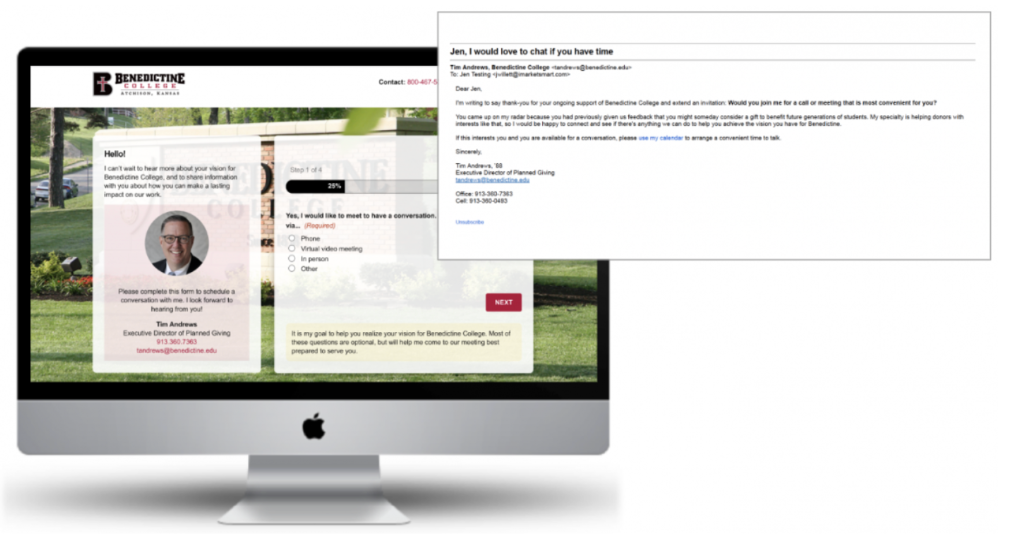
4. IRA Qualified Charitable Distribution (QCD) Tool
One-third of American households own individual retirement accounts (IRAs), and 31% of the $8.4 trillion saved in retirement assets in the U.S. is held in IRAs.
Once an IRA account owner reaches 73 years old, they must begin withdrawing funds—known as the Required Minimum Distribution (RMD)—from their account every tax year. However, most people don’t know they can make a Qualified Charitable Distribution (QCD) starting at the age of 70 ½ , and at 73, they can make a QCD to satisfy their RMD while gaining tax benefits, avoiding IRS penalties, and making a greater impact than they ever imagined possible.
IRA holders who are at least 70 ½ years old but not yet 73 are not legally required to make RMDs. However, this group of people is still eligible to make a QCD, and may find tax benefits in doing so.
However, many supporters are not aware that they can use their IRA to support their favorite charity, or that they may satisfy their RMD with a qualified charitable distribution (if they are at the eligible age). Those who are 73 and older may find calculating RMDs confusing, possibly leading them to assume that giving IRA funds to charity via QCD might be confusing, too.
And finally, financial institutions (custodians) do not always make it easy or convenient for IRA holders to transfer the funds to charity, and most CPAs/advisors tend to calculate RMDs for their clients without recommending QCDs.
As a result, MarketSmart determined that there should be a much better (and easier!) way for supporters to make qualified charitable distribution gifts. So we created one! And you can too.
The QCD Tool aims to educate supporters in the WHY stage of this type of consideration, while also helping supporters in the HOW stage so they can quickly select their IRA custodian and receive an IRA distribution form that is automatically pre-filled with their name and contact information.
Supporters love it because it removes friction from the philanthropic giving process.
The QCD Tool makes it easier and more convenient for people to give so your organization gets:
- More major gifts now, as well as legacy gift leads.
- More legacy gifts by beneficiary designation.
- Habitual QCD giving.
- A gateway to larger major gifts during the supporters’ lifetime, or a bequest (assuming the fundraisers build relationships with QCD donors).
5. Online Will Tool Complement
Just before the Covid-19 pandemic hit several companies began offering online tools to help consumers create wills or trusts more quickly and easily. Each of them includes a question that asks users whether they want to set aside a gift to charity after their lifetime. However, some make money by charging the end users while others charge nonprofits for a chance to customize the tool so the users get asked whether they would like to leave a legacy gift to the sponsoring charity that paid to tailor the tool. Then the paying organization must market the offer. They need to promote the online will-writing tool to their supporters, donors, staff, and volunteers as a free gift.
Although, unfortunately, most don’t have the budget to pay for such an arrangement. And the ones that can afford it don’t know how to manage that kind of marketing campaign effectively. Too often they simply promote the complimentary tool but fail to thank the new legacy donors in a timely fashion or stall before stewarding the relationships properly. But it doesn’t have to be that way. The Online Will Complement can help.
First and foremost, instead of taking a chunk out of your budget, it works by charging your donors instead. Plus, it’s turnkey—’done-for-you’ by your friends at MarketSmart. And finally, it automatically nurtures relationships by stewarding your new legacy society members properly—giving them the attention they deserve.
Also, it encourages each new legacy society member to disclose more information about their gift(s) as it gently leads them to fill out a gift notification page. Plus, using a brief questionnaire opens the door for each new legacy society member to provide feedback and share information about why your mission is important to them. Then it inspires them to consider additional legacy gifts and major gift opportunities while offering them opportunities to provide feedback or arrange meetings, calls, or Zoom visits.
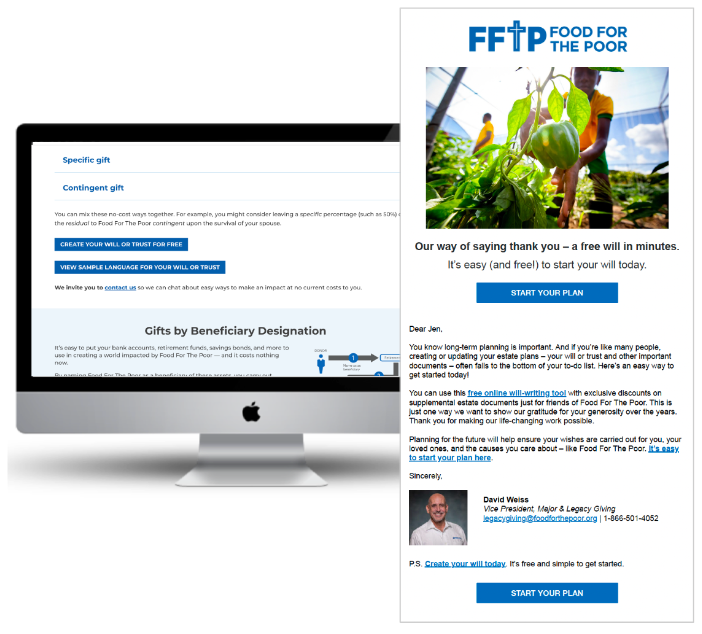
6. Legacy Challenge
Most of the time, when you try to engage supporters about legacy giving, they start to think about their own death. Then, naturally, they do their best to avoid the conversation.
However, at MarketSmart, we have found that assigning a deadline along with a non-death-related positive outcome helps facilitate the consideration of this type of gift.
The Legacy Challenge employs this mixed-packaging approach by offering supporters the opportunity to activate a large, immediate donation in their name (thanks to a generous major gift sponsor) when they document a legacy gift within a certain period of time.
Here’s one example of how it can work.
Lacey, a noted environmental activist and major donor at World Wildlife Fund, planned an outright donation of $75,000. The gift officer approached her to see if she would consider using those funds to sponsor a Legacy Challenge Effort. Their goal was to document 30 new legacy gifts within six months. Lacey agreed, and issued a challenge to her fellow supporters: she pledged to make a $2,500 immediate donation to the World Wildlife Fund in the name of anyone who documented a legacy gift within the next six months, up to $75,000.
By packaging legacy gift documentation (an often-avoided task) with the positive outcome of a large immediate donation, the Legacy Challenge is a powerful combination of blended giving, social norms (otherwise known as the bandwagon effect), and urgency. This approach leads donors through the avoidance stage of the consideration continuum and incentivizes them to take action right away.
The time frame associated with the Challenge effectively becomes a deadline for their legacy-giving decisions.
Plus, once the Challenge goal has been met, it’s an excellent way to highlight the importance of legacy gifts to other supporters by featuring the Challenge participants who indicated they want to be recognized in a prominent way. Featuring them with the Challenge sponsor really puts a “face” to the effort—thereby normalizing legacy giving and inspiring others to consider a legacy gift commitment too.
The Legacy Challenge helps address something that holds people back from making a decision— the idea that they will not be able to see the impact of their legacy gift in their lifetime. By participating in a Legacy Challenge, they can see and feel good about the present impact of their gift disclosure because there is an outright gift tied to their planned gift.
7. Stewardship Series
When it comes to legacy gifts, most organizations spend too much time focused on uncovering hidden gifts or closing more of them. Sure, it’s important to find out who planned a secret gift and to inspire donors to make planned gift disclosures.
But, believe it or not, closing these kinds of gifts is just the beginning of the fundraising process, not the end. That’s because most legacy gifts are revocable and many people change their plans near the end of their lives. In other words, the key is to make sure your supporters never change their minds (or if they do, it’s to increase their gift).
This is especially true for early deciders because, according to Dr. Russell James, “Estates where a charitable component was always reported generated a disproportionately large share of the total charitable estate dollars (US) transferred. This supports the argument that getting a charitable component into the estate plan earlier may generate larger gifts.”
That’s why, once an organization knows that a supporter has planned the ultimate gift for their organization, it’s imperative that they steward the relationship in a meaningful way for the rest of the supporter’s life. If that does not happen, the gifts won’t happen.
Dr. James explains why: “Among decedents who had confirmed the presence of a planned bequest gift to the charity, 35% generated no estate gift. This lost gift rate varied from 17 to 60% across different organizations.” However, it gets worse when you look at the retention rates of charitable estate components over 10 years. Dr. James found “the ten-year retention of a charitable estate component is [only] approximately 55% among adults over age 50.” In other words, 45% of the legacy commitments you uncover will probably never result in any revenue for your cause whatsoever.
Since most legacy gifts are revocable, if you really want to turn commitments into dollars, you’ve got to invest in stewardship. Stewardship creates a relationship that keeps the donor engaged and sustains their intent to give. It also makes it more likely that they will make additional planned gifts, increase the amounts of those gifts, or make major gifts, too.
The Stewardship Series can help. It begins once an organization learns that a supporter has planned a bequest to their organization. That’s when fundraising automation launches an eight-month email series that starts with a questionnaire that seeks to understand each individual supporter’s desires, reasons for giving, how they want to be stewarded, and how they would like their gift(s) to be used after their lifetime. This is not just fair. It’s essential! Legacy supporters want to feel like a special partner in the organization’s mission. They deserve to be engaged with valuable offers and to get recognition for their support.
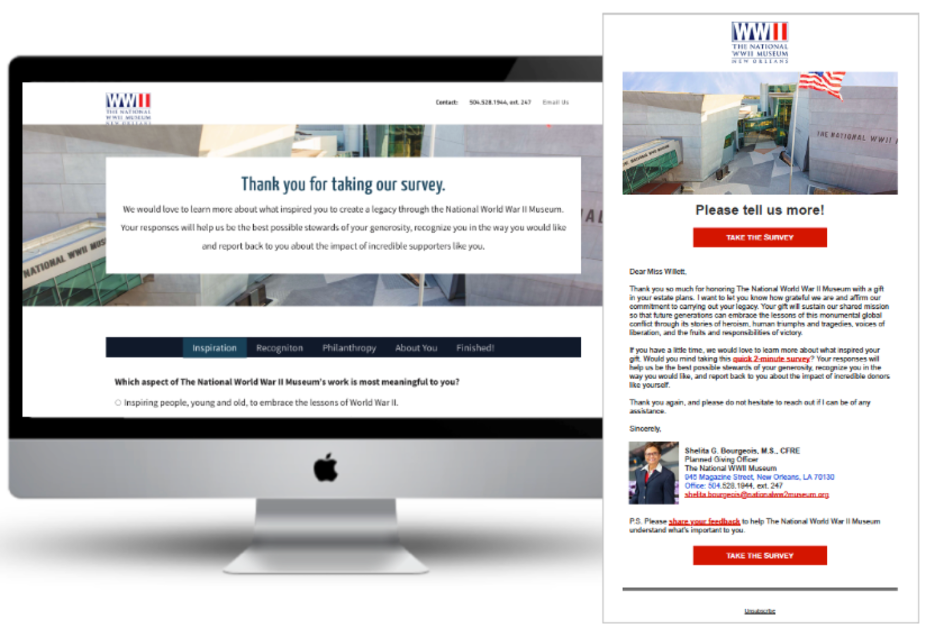
8. Donor Advised Fund Tool
The National Philanthropic Trust’s 2022 DAF Report revealed that donor-advised funds (DAFs) contributed an estimated $45.74 billion to qualified charities in 2021. That’s a 28.2% increase from the previous year. It's clear that DAFs are not just a trend; they're becoming a philanthropic powerhouse.
So, you may be asking yourself, "How can I tap into this growing resource? How do I identify supporters who have a DAF?" That's where MarketSmart's comprehensive DAF Effort shines. Our approach lets your supporters easily signal if they have a DAF or are interested in opening one. From there, we provide them with the nuts and bolts they need to make a difference.
One reason our approach is so effective is that it nudges DAF holders to actually use their funds for their philanthropic goals. Sometimes, these funds are "out of sight, out of mind," but we help keep them front and center.
With our DAF Tool, supporters who indicate they have a DAF receive timely, value-driven reminders throughout the year. It's all about helping them remember to utilize the funds they’ve already earmarked for good causes.
Our program doesn't just educate—it activates. Whether supporters are still considering why they should use a DAF or they're ready to make a grant, we guide them through each step. And yes, that includes helping them name your organization as a beneficiary or even setting up a meeting with your team.
By partnering with MarketSmart's DAF Tool, you'll gain the ability to:
- Segment donors based on whether they have a DAF
- Reconnect with supporters who have given through DAFs before
- Introduce your organization's own DAF options to those who are new to the concept (if applicable)
- Offer insights to advisors who guide their clients on philanthropic giving
- Keep your organization top of mind when donors are considering their annual philanthropic and DAF contributions
How to Measure Success
If you decide to invest in fundraising automation, at some point someone will probably ask you about its performance.
That’s good. You should welcome that!
But how can you be sure it really is working?
There are three categories of metrics your marketing automation system should be capturing:
- Email metrics
- Engagement metrics
- Recency indicators
These metrics make up your supporters’ digital body language—measurable online behaviors that tell you how engaged a particular person is.
- Email metrics. Open rates are the least useful. They matter, but it’s possible to open an email and not even read it. Clicks tell you more because people click to involve themselves further. Click-through rates tell you the percentage of the people who received your email in their inbox and subsequently clicked a link in your message. For example, if your click-through rate is 5%, that would mean five out of every 100 people who received your email subsequently clicked a link within it.
- Engagement metrics. Engagement matters more than email metrics because they reveal more intentional self-involvement. For instance, deep engagement might be reflected by the amount of time a supporter spends viewing multiple pages online, or if they download content or view a video. A deeply engaged person is someone who has mentally and emotionally involved your nonprofit in their lives to a more significant degree. For larger donor prospects, these are the people you might add to your list for one-to-one follow-up.
- Recency indicators. Even more telling than engagement is recency. When is the last time a person engaged with your content, and which content was it? Was it simply related to your mission, or does it signal readiness to discuss a major gift? For instance, did they forward specific bequest language you supplied online to their financial planner so they could leave your nonprofit in their estate plan? If so, wouldn’t you move them to the top of your list for outreach? Recency is how your gifts officers know who to call this week and what to say (without being spooky, of course).
Automation enables you to manage the timing of your outreach to hyper-qualified donor prospects so it aligns with their needs.
Consider this true story. A 78-year-old woman with no children had been widowed. She accumulated a fair amount of wealth (including two houses) and wanted to sell one so she could use some of the money to make several large gifts to a few nonprofits. But she was grieving and didn’t want to deal with any of that right away.
She expressed this to one of her beloved charities because they offered her opportunities to take surveys and she filled them out over time. In fact, she divulged these very specific details in an open comment box near the end of one survey.
The charity thoughtfully leveraged fundraising automation to deliver value politely and persistently to her in the form of highly relevant emails that were sensitive to her readiness while they collected valuable data on her digital body language.
They were patient. They gave her space. No asks. No requests. Just a few emails delivering value now and then, to stay on her mind and build credibility over time.
When she was ready, she made that known by responding to one of the automated emails she received. Later she met a gifts officer and they worked together on a tax-wise plan. Now all of the money from the sale of the home went to that single charity. The others, she said, either annoyed her or forgot about her altogether.
Fundraising automation did this!
Your New Normal with Fundraising Automation
Just do it.
If you really did this—really set your mind to implement fundraising automation in all or most of the ways we’ve just described—it would revolutionize your fundraising, marketing, and major gifts strategies and processes.
That word, revolutionize gets tossed around too often. It has lost some meaning.
But this is a sea change from how almost every nonprofit does things right now. You’re spending almost all your time and money reaching out to donors who make up about 7% of your revenue because you don’t have a better way to engage with your supporters properly at scale—especially the high-value ones with massive giving capacity.
Wealth-screening companies and predictive analysis give you amazing information too. But in order to understand why each supporter cares, how they rank your cause with others they give to, where they reside in the consideration process for giving assets (not just cash)—and so much more—you need to engage with them. And doing that properly at scale takes time and costs money.
But with fundraising automation, it’s easy. Your major gifts fundraisers will have this automatically gathered knowledge at their fingertips:
- Why each supporter cares about your mission.
- How your mission relates to their life, their life story, how they hope to find meaning, or how they hope to live on in the minds of others after their lifetime.
- Who to talk to: who is considered an active, highly qualified, outreach-ready donor prospect.
- When to reach out to warm or hot self-qualified prospects (instead of interrupting and badgering cold ones).
- What to say when they have the conversation, based on donor verbatims and digital body language.
- Key demographic information, such as whether or not they have kids.
- Insights into the kinds of gifts they are considering.
- Each individual’s prospect’s preferences, concerns, interests and feelings.
- And more.
Your donors will feel like they are in control. They’ll feel informed, respected, valued, and heard—not like targets or ATM machines. As a result, their trust will grow.
And make no mistake: no major transfer of wealth ever happens without trust.
Here’s a rather simple example that reveals how we know this. Below is an email from a supporter of a nonprofit that uses MarketSmart’s Engagement Fundraising automation system. What’s important to note as you read the supporter’s message is that the email they are responding to was a fairly basic automated email. But it felt so personal and real to them that they thought it was sent only to them.
In reality, a similar email was also sent to other donors who shared certain commonalities with that donor: a persona bucket. But because it connected with them so well, the supporter replied as if someone had personally reached out to them.
Here’s their email reply, followed by the automated email that was initially sent to them:
Do you see how amazing the supporter’s reply was?
She addressed the fundraiser by name. Revealed her lifelong passion and support for similar causes. Spoke to her as if speaking to a friend or new acquaintance. And even compared this to other thank-you letters she’s received in the past.
This tells you many things, but one of them is clear: people pay attention to your communication or lack thereof. And good communication gets noticed and appreciated!
When real human beings reply positively to your automated email because you delivered value and they feel appreciated, you’ve won. And so have your supporters.
So why aren’t more nonprofits using automation for raising major gifts?
Good question.
If fundraising automation is so great, why aren’t more large and mid-size nonprofits using it in the ways we’ve described, particularly with regard to major donors?
Here are a few of the main reasons:
- Lack of staff
- Overworked staff: your team is already maxed out and doesn’t want to learn another system
- Too much turnover makes it hard to launch and sustain new initiatives
- No time or extra funds to train on a new system
- No experience with the system, so even if they buy one, it just sits there or gets under-utilized
- No knowledge of best practices and benchmarks
- No plan for generating a return on the time and money investment
- Cost
Many nonprofits that use marketing automation use it mostly to engage with low-dollar donors. You’re probably sending out automated giving receipts. Hopefully, you’re also using autoresponders and thank-you emails. But as discussed earlier, that’s the easy stuff. That’s basic automation.
To effectively identify, qualify, prioritize, and engage with mid-level, major, and legacy donors, you need an automation system that can do a lot more than send emails.
For other nonprofits, the problem is that they just bought a different system that on the surface seems to do many of the same things, such as Salesforce (it doesn’t). So they’ve already committed to pay for a system, spent money and time training on it, and now they’re hoping the staff people they’re investing in don’t leave a few months later. Sadly, too often they do leave. Or they never get around to implementing the tools. Or even worse, they do implement them, but do it incorrectly because they don’t know what really works. Then they cause more harm than good.
Remember, tools are like hammers. Some people build stuff with them. Others just break stuff.
Introducing MarketSmart’s Engagement Fundraising System
Turnkey fundraising automation
Our system does everything you’ve just read at low cost, and comes with a 10:1 ROI guarantee.
You’ve just read a lot about fundraising automation. It probably sounds great, but also somewhat daunting. Seems like it would require more staff, a lot of work to set up, and a lot of training to use it well. It does.
But the good news is that you don’t have to do any of that.
MarketSmart will do it for you.
MarketSmart uses inbound marketing and fundraising automation to help nonprofits improve their donor discovery and cultivation effectiveness so they raise more money more efficiently.
You will uncover more high-dollar donors among your lists than you ever found before, and you will succeed in engaging with more of them.
Plus, your retention rates will increase at every giving level. Your reactivation rates will increase too. Your supporters will give more. And, as a result, your lifetime value per donor will grow dramatically.
Hard to believe?
MarketSmart has measured the effectiveness of our revolutionary Engagement Fundraising System for over a decade, and we can show you plenty of case studies. Here’s one report of the results generated for Benedictine College, a small school in Kansas.
They struggled with the usual—small staff, tight budgets, lack of time, pressure to raise more money faster. But they struck gold when they began to leverage technology to multiply their effectiveness. Here are the results after five years of turnkey fundraising automation.
Total giving: on average, total giving among supporters engaged with MarketSmart’s System was 1,119% greater than giving from those not engaged by it.
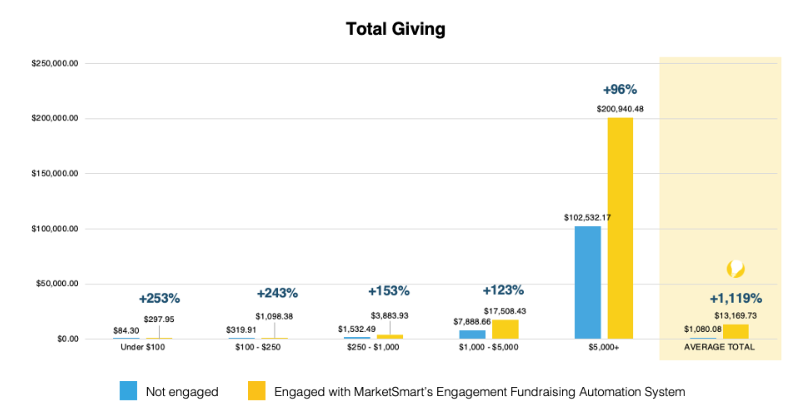
Retention: in every giving category and in every year, engaged supporters retained at greater rates.

Reactivation: engaged supporters that were reactivated gave much more on average.
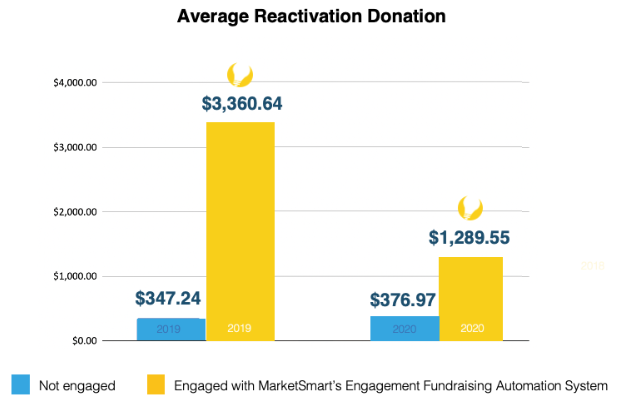
Upgrading: donors at every giving level upgraded their giving amounts. On average, 94.26% more donors increased their giving than those who were not engaged with fundraising automation.

Upgrade revenue: on average, engaged supporters increased their giving by 474.54% more than those not engaged.
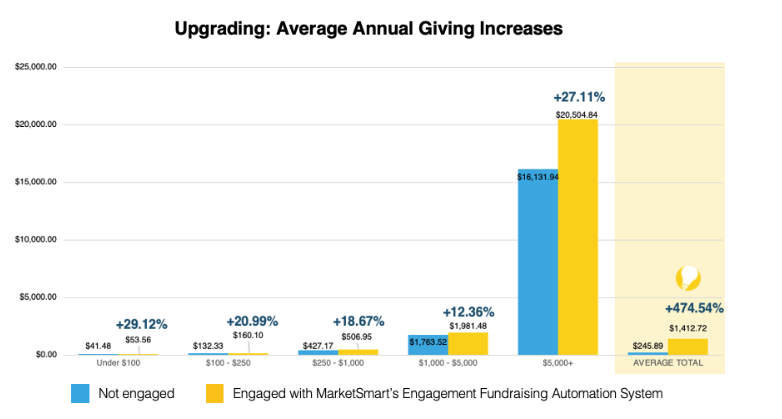
And remember, Benedictine College’s investment each year was less than the cost of a single gift officer. Plus, while they could have invested in software, staff, training and more to develop and maintain a fundraising automation system on their own, they determined that it was more cost-effective to employ MarketSmart’s done-for-you software and service model.
They recognized that it only required an investment equal to what their organization would have paid for marketing automation software alone. But with MarketSmart they also got all this:
- Experienced copywriters who know what words work.
- Skilled front-end website designers who know what designs and layouts encourage engagement.
- Talented back-end engineers (coders) who use the data to improve our system and algorithms.
- Dedicated customer success staff that keep your best interests in mind as they help you get the most out of the system.
- Monthly (or quarterly) strategic counseling meetings.
- Custom scoring adjustments to improve your prioritization scores over time.
Unlike private sector marketing automation software as a service (SaaS), you won’t have to navigate a bunch of features you don’t need. And you won’t have to become a software contortionist to rework systems built for private sector businesses to fit your unique nonprofit needs.
MarketSmart’s Engagement Fundraising System is not marketing automation—it is fundraising automation, a technology-enabled service. That means we do it all for you—turnkey!
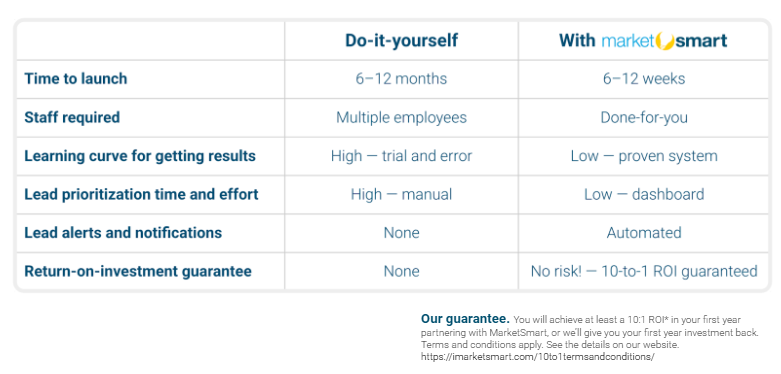
Our system was built specifically for nonprofits who want a better way to generate more revenue from major donors, but that doesn’t involve hiring a bunch more communications staff or more gift officers.
You know that wealth screening isn’t enough. Viewing giving histories is better, but still not enough. You need self-reported donor ‘verbatims’ and ‘digital body language’ to truly know who to call, when to call them, and what to say.
Our ready-to-use system makes it possible for you and your overworked colleagues to use technology and automation to build more and better relationships with all of your supporters. Using technology at scale allows you to cultivate especially wealthy, passionate, philanthropically-minded donor prospects.
We take the tedious and time-consuming tasks off your to-do list so your major gifts officers can do the fun stuff: meet with qualified prospects who want to speak with them.
- Your team will close more and bigger gifts, and they’ll do it faster.
- They’ll do away with wild goose chases.
- They’ll be able to say goodbye to cold-calling misidentified donors supplied by wealth-screening lists.
- They’ll be able to avoid embarrassing themselves by suggesting ask amounts that are nowhere close to what people can or want to give.
- They’ll be able to focus more on building one-to-one relationships at scale (thanks to technology) with philanthropically-minded supporters when those supporters are ready.
Our Engagement Fundraising System will free up your communications team to work on other matters since it is unlikely that fundraising automation aimed at wealthy, philanthropic-minded supporters is their expertise). And besides, they’d never be able to capture all the best practices and optimization metrics MarketSmart has been compiling and improving upon for over a decade.
Let us do the heavy lifting. Your team will be able to employ a part of MarketSmart’s System that compels major donor prospects to arrange appointments with your gift officer on their own. That’s right: one component of the system actually arranges meetings for your staff when the supporters want to talk turkey.
No more lip service.
Everyone talks about donor-centric fundraising. But when it comes to major and legacy gifts fundraising, hardly anyone knows how to do it in an efficient, optimized, consistent, and respectful manner that doesn’t require an army of overworked fundraisers and support staff.
MarketSmart helps donors be the best version of themselves. It cultivates supporters and brings to the surface those who have already decided in their hearts to give. They want to give; they just haven’t figured out exactly how to do it, or when, or where.
With the persistence of respectful fundraising automation that doesn’t beat them over the head but engages with them at a level that matches their preferences, you will discover more donors who want to give larger gifts than you ever would have found using the old methods.
Our Engagement Fundraising System has been quietly powering some of the most successful organizations and nonprofit institutions around the world, such as Girl Scouts of the USA, City of Hope, Habitat for Humanity, PETA, The Salvation Army, numerous public radio stations, dozens of colleges and universities, and plenty of smaller organizations in the United States.
And don’t worry—MarketSmart is not a CRM. You can keep the one you have. Instead, ours is a turnkey lead generation, qualification, cultivation and prioritization system. It’s a complement to your CRM, not a replacement for it.
Additionally, MarketSmart is not just a software provider. We are a tech-enabled services provider. There’s a big difference. Although we supply the technology, we also provide experienced people to run it for you. So our system powers the automation while our team helps you get the most out of it.
We know what works. And we know what doesn’t. Our experience helps you avoid pitfalls and learning curves.
And the BEST NEWS OF THIS ENTIRE REPORT is: In most cases, you can do all this while spending less than 1% of your current fundraising budget.
Take the Engagement Fundraising Challenge
Carve out less than 1% of your fundraising budget to thwart fundraising climate change by testing our Engagement Fundraising System for one year. If you don’t generate a return on investment (ROI) of at least 10X of your investment (thanks to pledges and realized dollars in the bank), we’ll give your money back.
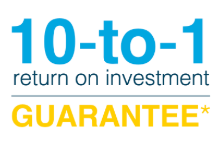
*For qualified organizations only. See our terms and conditions here: https://imarketsmart.com/10to1termsandconditions/
How do you take the challenge?
Your first step costs nothing: request a free Opportunity Analysis (valued at $5,000).
This process will evaluate your organization’s past fundraising efforts and results. It will show you in graphic detail if and how much fundraising climate change is weakening your effectiveness at delivering on the promise of your mission. You’ll be blown away by the information we provide in our Opportunity Analysis—at no cost to you whatsoever.
Remember, we’re not a software company. Most software companies just offer a free demo. You will get a free demo as part of this, but for the demo to have meaning, we combine it with the Opportunity Analysis. This way, the demo is personalized to your specific strengths and areas of growth.
Most other fundraising consultants would charge several thousand dollars for an analysis like this. We offer it free, as long as people at your organization who have the power to make decisions on whether to purchase a service like this are in the room.
Otherwise, whoever we present to will have to go to someone else and try to re-explain it all. And that doesn’t result in an informed decision-making process.
To request your Opportunity Analysis and accompanying free demo of MarketSmart’s Engagement Fundraising System, click the button below.
We do the marketing; you get the results.
MarketSmart is what’s known as a ‘done-for-you’ service.
We write the surveys. We create the emails. We design your automated content. We create the landing pages and the microsites.
We know how big to make the buttons and where to place them. We know which words work. Of course, you and your team have the opportunity to make edits as well. But we do all the heavy lifting for you. We’re the experts. We do the marketing. You get the results.
If you have turnover or your staff is overworked, it won’t matter because our team will keep working on your behalf. You don’t have to spend money to train anyone, because our team does most of the work.
Your team doesn’t need to master any new systems, because, for the most part, they won’t be using it.
We run the system and collaborate with your team as needed. The fruit is revealed when your major gifts officers are given actionable information they can take and use immediately. After all, they don’t want data. They want meetings.
With what our system produces, your team will raise more dollars per gift officer. They will be more focused on engaging prioritized and optimized leads who are active, who exhibit recency, and who have responded enough to provide helpful verbatims so your gift officers know what to say and how to say it—at the right time, of course.
Our system is, in a sense, a virtual gift officer. It does the mundane tasks the human gift officers hate doing, and empowers them to do what they do best.
Lastly, as for cost, our system can be implemented for less than 1% of your current marketing budget.
Can you spare 1% of your marketing budget to more effectively reach the handful of high-dollar donors who supply more than 2/3 of your revenue?
With that math, we should hope so.
Fundraising climate change isn’t going away
In 2020, postage grew by 6.5% on average, with another average increase of 1.8% set for 2021. Interruptive, irrelevant direct mail (junk mail), telemarketing and spam aren’t working the way they once did. And besides, spam is wrong! Just because nonprofits are not required to adhere to the CAN-SPAM Act doesn’t mean they shouldn’t.
Times are changing, and so are donor preferences. Donor trust is declining. But you can thrive in the era of fundraising climate change. Hundreds of organizations and institutions just like yours have discovered how.
Take the Challenge—Request an Opportunity Analysis today!
The only way to see how the Engagement Fundraising System will customize itself to your specific nonprofit’s mission and donors is to do an analysis and see the demo.
We simply ask that you get at least one person on the call who plays a key role in making decisions related to services such as ours.
And remember, we guarantee you will generate at least 10 times the cost of our system in new planned giving and major gifts revenue within the first year, or you get all your money back.
And our system costs less than 1% of the fundraising budget at most mid-size and large nonprofits.
It’s a relatively small investment with a very strong potential for a great reward that will serve to advance and solidify your nonprofit’s mission for many years to come.
You will stave off the effects of fundraising climate change that are threatening the livelihoods of many other organizations. You will meet more new donors who are happy to hear from you. You will help them be the best version of themselves.
If MarketSmart is a virtual gift officer applicant, the Opportunity Analysis and demo are the interview. Click below to interview your virtual gift officer and request your free Opportunity Analysis.
About MarketSmart
MarketSmart is a revolutionary ‘Engagement Fundraising’ firm that combines its proprietary email marketing automation software with complimentary support services to help you be the fundraiser you always wanted to be.
Fundraisers, nonprofit leaders, and board members like you come to us when they realize their traditional fundraising efforts are no longer working. They are tired of low donor retention rates, high costs of acquisition, weak relationships with major donor prospects, operational inefficiencies, and more—all due to 'fundraising climate change.’
We help them implement our 'Engagement Fundraising System’—a powerful ‘done-for-you' software and service duo that helps fundraisers land meetings with the wealthiest and most passionate supporters when they are ready to build relationships centered around donating major gifts of assets.
Unlike big data or mysterious black box wealth screening services, our System is donor-driven. It inspires supporters to engage and explain why they care. Then it signals when they need help—so your team becomes more effective and efficient as a result of knowing when to make outreach to optimize your operations.
Bottom line: It positions your team for success.
Plus, there’s no risk because it comes with a 10-to-1 return on investment (ROI) guarantee.
That’s why hundreds of organizations of all sizes in every sector and on 3 continents use it.
However, we find that we can only have a dramatic effect on about 60% of the people we talk to. Honestly, MarketSmart is not a good fit for everyone. That’s why we don’t ‘sell’ to people like you. Rather, we facilitate their decision-making process through collaboration.
We do so by providing you and your leadership with an Opportunity Analysis at no cost whatsoever. The analysis includes a deep dive into your data (something akin to what many consultants charge thousands of dollars for).
Then we present the results to you and your team to determine whether or not your organization should strongly consider employing our System (and if it would be eligible for our 10-to-1 ROI guarantee).
Organizations that agree to move forward often realize much more revenue than we predicted. In actual fact, some even generate 100-to-1 ROI.
So why not consider learning more about our System today? GET A DEMO HERE
Judge us
by the company
we keep.
.png)
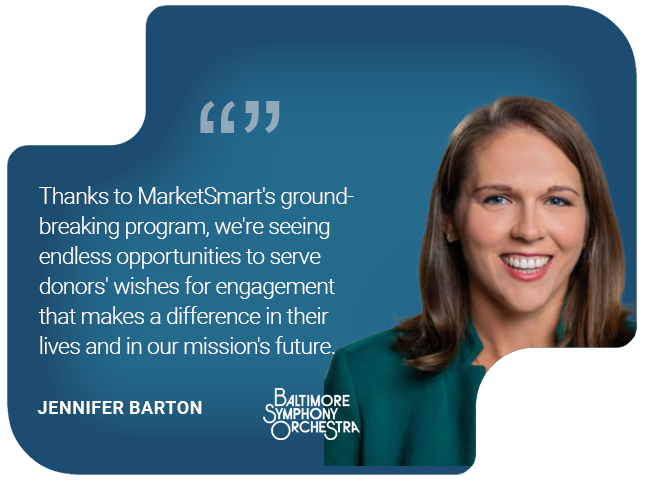


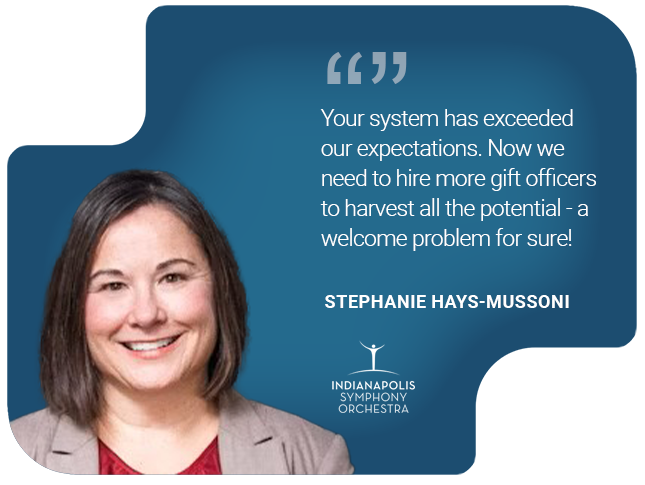
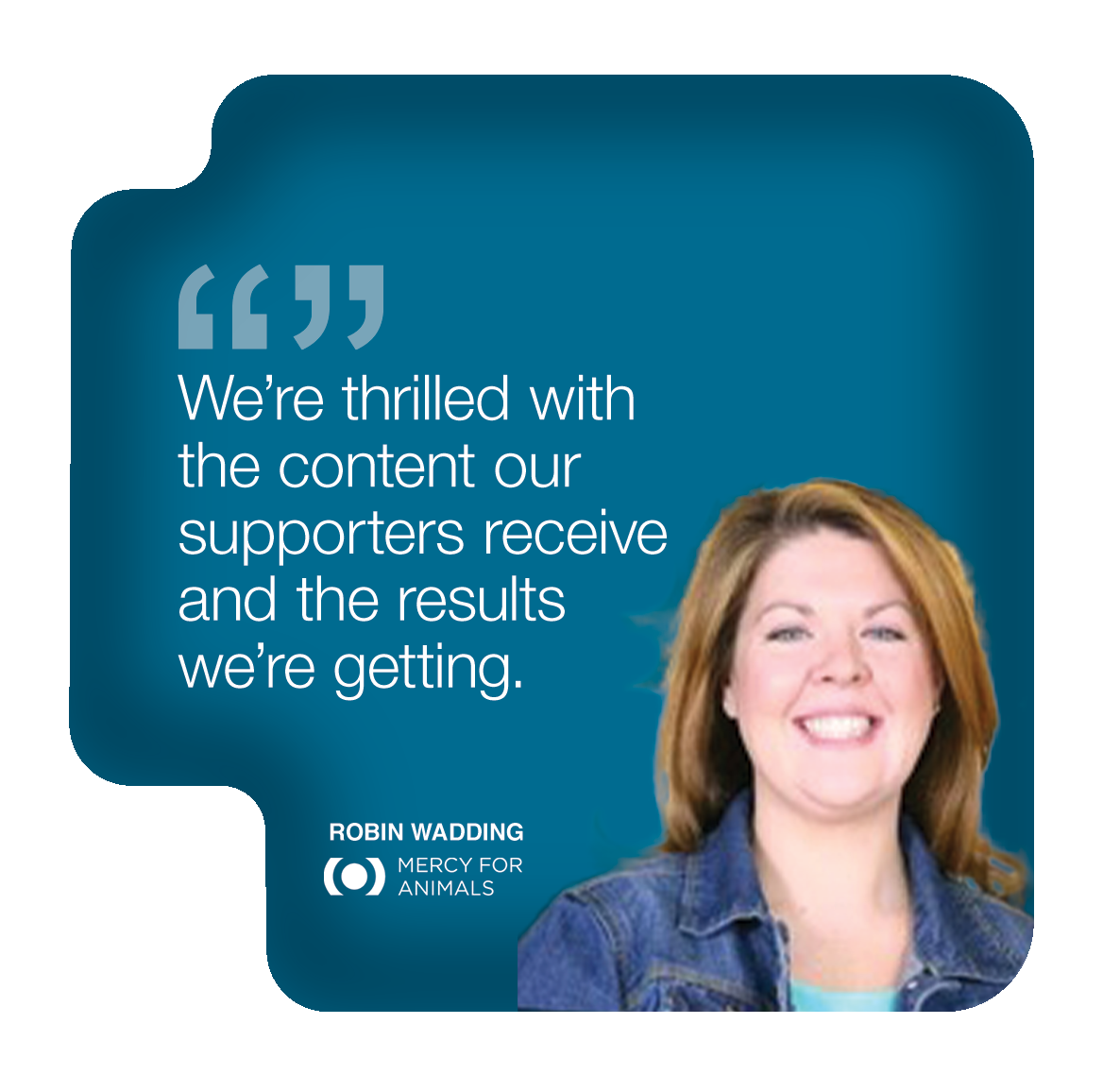

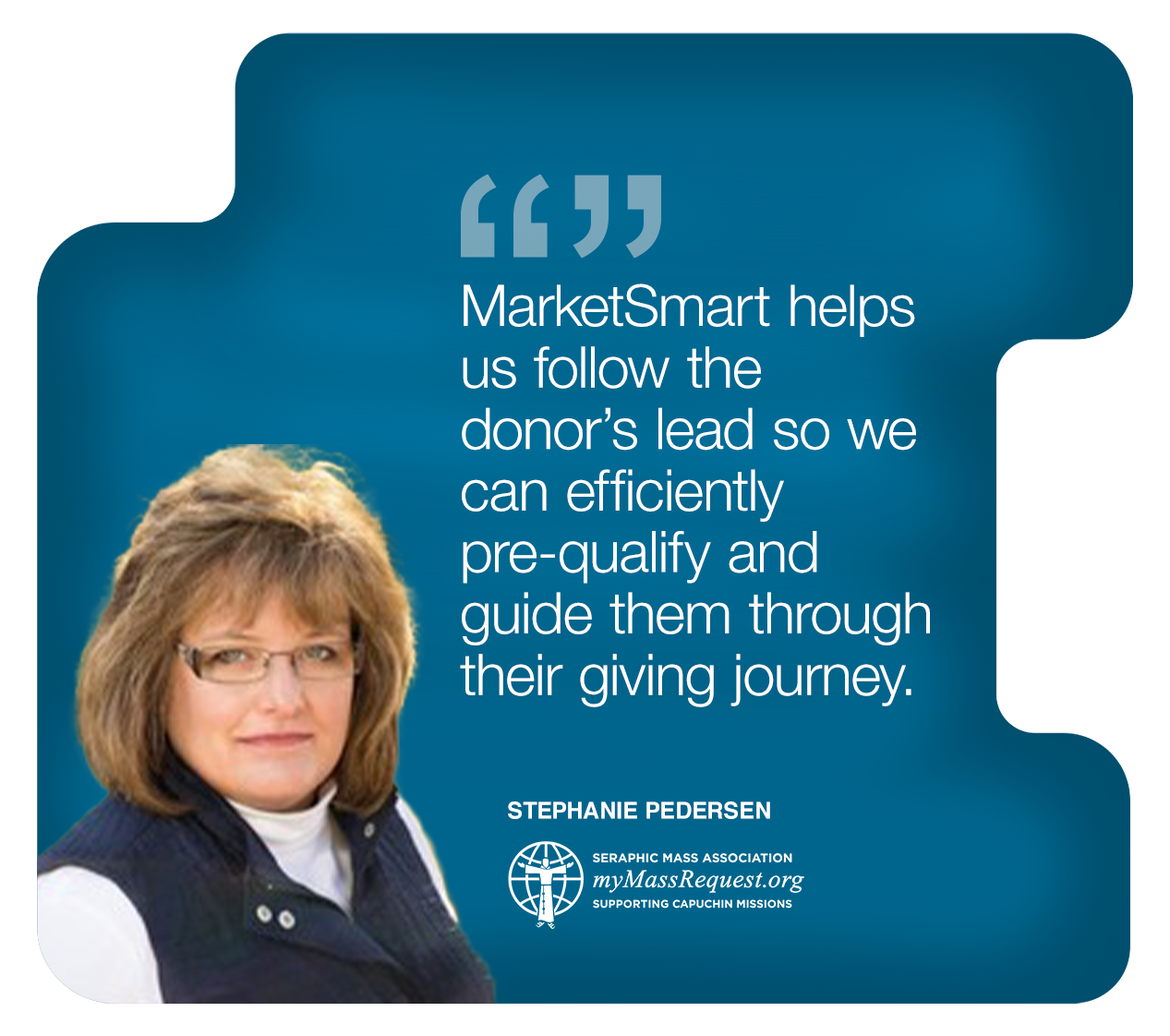


imarketsmart.com
Donor-driven major, mid-level and legacy
gift marketing guaranteed to deliver.
